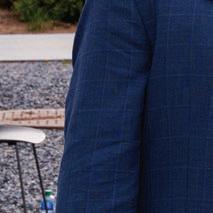
















“Seeing
—
Brenda and Jack C. Kilgore, GMGT 1972












































“Seeing
—
Brenda and Jack C. Kilgore, GMGT 1972



























As a Georgia Tech alum, you know there’s something magnetic about this place. It’s where your career journey began and your ambition took root. Returning to Tech to earn your graduate degree can accelerate your career growth, expand your network, and gain leadership experience in this evolving world of business and technology.
M.S. Major in Management:
A nine-month program that provides education and resources for early career business and non-business students to build a solid business foundation.
M.S. Major in Management Online:
The same program curriculum as the on-campus M.S. Major in Management, but offered online for students who need flexibility.
Return to Tech and learn
Full-time MBA:
Traditional two-year MBA with a focus on experiential learning and top-ranked career services.
Evening MBA:
Flexible, part-time MBA designed for working professionals with evening and online classes.
Executive MBA:
Globally focused MBA for experienced professionals with cohort-driven weekend classes.
FFOURTEEN ASTRONAUTS. ousands of alumni working at NASA, SpaceX, Intuitive Machines, and Blue Origin. And even more Yellow Jackets in the aviation industry. It’s no secret that Georgia Tech is a launching pad for careers in space and aviation. Every time I connect with alumni, I remember how far our impact reaches.
A few summers ago, I visited the Gulfstream Aerospace facility in Savannah, Georgia, during one of President Cabrera’s summer tours. While touring the production lines, an alumnus explained a special tradition to me: Each

employee who works on the jet signs the fuselage before the outer skin is added. en he leaned over and said with a large grin, “You know, George P. Burdell has signed every Gulfstream fuselage that’s rolled o the line.” Of course, the Institute’s impact goes far beyond the factory oor.
John Young, AE 52, HON PhD 03, remains a legend in space exploration. Not only was he the first astronaut to fly six space missions, he and his team also






brought 209 pounds of lunar material back to Earth. A piece of one of those Moon rocks is on display in the Georgia Tech Library.
The Institute also has a strong partnership with Delta, Atlanta’s hometown airline. Delta employs many Yellow Jackets, and we’ve even hosted events like the President’s Dinner at the Delta Flight Museum, which shows how deeply embedded Tech is in the aviation world.
I’m also reminded of the moments that speak to the power of our alumni network. A few years ago, President Cabrera, several other Institute leaders and alumni, and I met with Yellow Jackets working on Artemis at NASA’s Kennedy Space Center. Alumna Robyn Gatens, director of the International Space Station and acting director of the Commercial Space ight Division, helped make it happen.

It was amazing, but what really stood out to me was the power of our alumni network in the space and aviation industry.
In this issue, you’ll read about Tech’s impressive astronauts and learn about Yellow Jackets designing the next generation of spacecra and aircra . These stories show that Georgia Tech continues to lead—on the ground, in the skies, in space, and beyond.
Go Jackets!

DENE SHEHEANE, MGT 91 PRESIDENT GEORGIA TECH ALUMNI ASSOCIATION
VOL. 101 | NO. 3
PRESIDENT & PUBLISHER
Dene Sheheane, Mgt 91
VP STRATEGIC COMMUNICATIONS
Lindsay Vaughn EDITOR
Jennifer Herseim
ART DIRECTOR
Steve Hedberg
COPY EDITOR
Barbara McIntosh Webb
COPYWRITER
Sharita Hanley
STUDENT ASSISTANTS
Alisha Tan, Joanna Xiao
EXECUTIVE COMMITTEE
Chair
Rita Breen, Psy 90, MS IE 92
Past Chair/Finance
Tommy Herrington, IM 82
Chair Elect, Vice Chair/Roll Call
Jimmy Mitchell, CE 05
Vice Chair of Engagement
Sam Westbrook, IE 99
Member at Large
Meredith Moot, Mgt 08
Member at Large
Alex Muñoz, Mgt 88
Member at Large
Amy Phuong, IA 05, MBA 14
Member at Large
Kenji Takeuchi, ME 94
BOARD OF TRUSTEES
Tommy Antonino, BA 15, MSA 22; Donnie Beamer, Econ 05; Matt Bishop, CmpE 06; Alexia Borden, IE 01; Jacky Cheng, IE 17; Kim (Kilpatrick) Civins, Mgt 92; Catherine Cooper, IE 90; Cynthia Culbreath, IE 93, MS IE 95; Adam Fuller, Mgt 93; Sid Gore, ME 17, MS ME 20; Derek Goshay, IE 93; Ryan Greene, ME 00, MS Econ 01; Craig Hyde, CmpE 05; TJ Kaplan, PP 13; Brandon Kearse, ME 08, MS CE 10; Kayla Kelly, Econ 16; Olivia Langevine, IAML 13; Sabrina McCorvey, IE 90; Mihir Pathak, ME 08, MS ME 10, PhD ME 13; Susan (Sutherland) Piña, IE 93; Kyle Porter, Mgt 04; Josh Roberts, IE 02; Sonia Sardana, IE 12; Greg Sitkiewicz, IE 00; Kofi Smith, IE 99, MBA 09; Miya Smith, IE 03; Russell Smith, Cls 98; Peter Stewart, CE 97; Casey Swails, Mgt 07; Rani Tilva, BA 18; Paul Trotti, ME 00; Hayley Tsuchiyama, ChBE 18; Ben Utt, IM 81; D’Andre Waller, ME 17; Kourtney Wright, CS 15, MS CS 23; Liz (Harriss) York, Arch 90, M Arch 95
GEORGIA TECH ALUMNI MAGAZINE (ISSN: 1061-9747) is published quarterly by the Georgia Tech Alumni Association, 190 North Ave. N.W., Atlanta, GA 30313. Periodical postage paid in Atlanta and additional mailing offices. © 2025 Georgia Tech Alumni Association For advertisements, contact Austin Schulte at Austin.Schulte@alumni.gatech.edu
POSTMASTER Georgia Tech Alumni Magazine, 190 North Ave. N.W., Atlanta, GA 30313 editor@alumni.gatech.edu (404) 894-2391




See all suggestions on Instagram @GTAlumni and on Facebook @Georgia Tech Alumni Association.


Illustration by Jacob Stead GEORGIA
A storage compartment for sugar — about 3,000 pounds.






Like stars in the sky, Yellow Jackets are everywhere you look in the space industry, working to advance human exploration of the cosmos.
On August 13, President Cabrera joined fellow Jackets to celebrate the opening of the Campus Cycle Track. The track originated from a 2019 award-winning senior Capstone project by Kimmie Hernandez, CE 19, Danielle Kronowski, CE 19, Poonam Patel, CE 19, and Rachel Still, CE 20.






I LOVE THE STORY of living in Miller Templeton’s apartment on 10th Street [Summer 2025, “The House on 10th Street,” Vol. 101, No. 2]. When I went to Freshman Camp at Camp Rock Eagle in 1967, Miller was the featured counselor. He was said to have been a student “forever” and had multiple degrees. He taught the freshmen to sing the Ramblin’ Wreck song (although I already knew). He was as much a legend as Sideways [the dog]. —Wade Barnes, Bio 71
I ENJOYED THE “Inside the Locker Room” article about singing the Ga. Tech fight song. I was amused that Coach Key did not sing “helluva” to his 6-year-old daughter. I sang the fight song often when my daughter was growing up. After she graduated from college and had her first job, she bought us tickets to the Tech vs. UVA game at UVA. We sat in the Tech section, and soon the fans started singing the fight song, using “helluva” and “to hell with Georgia.” My daughter turned around and looked at me and said, “You never sang those parts.” I laughed. Soon, she was joining in with the rest of the Tech fans and singing all the words. I hope Coach Key has a similar experience someday. —Carl P. Wylie Jr., MS IS 70
Student Housing Memories
Read more student housing memories under “Yellow Jackets Remember Dorm Life” at GTalumni.org/DormLife.



HERE’S MY COMMENTARY on “If These Walls Could Talk.” It was spring quarter of my freshman year (1970). I’d had a pretty tough start academically in the fall and not much improvement during the dreaded winter quarter. Having done rather poorly in both calculus and physics, I elected to change my major from Mechanical Engineering to Applied Biology. Gotta say, I was a bit down, and muscled through my last quarter as an “ME.” Returning to my dorm room (Towers 312) after class one spring day, I was surprised to see a notice on our hall bulletin board that shouted, “MEN! MEET YOUR COEDS!! TRY OUT FOR CHEERLEADING!” That evening, 32 guys inhabiting the third floor of Towers Dormitory held a meeting. It was determined that we would draw straws to see who would try out for cheerleading and get the phone numbers of the rare (50, if I remember correctly) female students on campus. I drew the short straw but blew my assignment! I never did get the phone numbers of the coeds who tried out (my future wife was one of them), but I did make the cheerleading squad. It was my great privilege to cheer on the Jackets from the fall of 1970 until the spring of 1973, and serve as captain from 1972 to 1973. Making the cheerleading team absolutely changed my attitude and my life. Simply stated, you can’t hang around fun, positive, energetic, and exciting people without feeling pretty good about everything. My grades shot up, campus life improved with such great teammates and friends, and my self-confidence soared. To this day, I am most thankful that I had that quirky opportunity to try out for a team I never intended—or expected—to make. Thanks, residents of the third floor of Towers Dormitory, and thank you, Georgia Tech! —Wayne Kerr, ABio 73, MS ABio 74



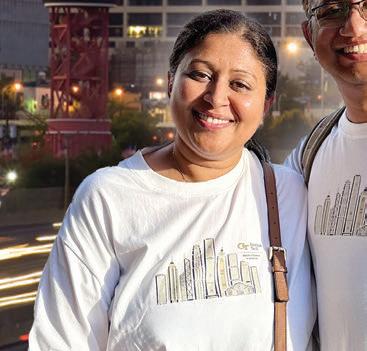




When husband and wife Sanjay Mathan and Sreejisha (Sree) Purushotham decided to pursue their master’s degrees together through Georgia Tech’s Online Master of Science in Analytics (OMS Analytics), they weren’t just advancing their careers — they were fulfilling a shared dream, both for themselves and their children.
What inspired you both to pursue an OMS Analytics degree from Georgia Tech?
Sree: Georgia Tech was more than just a university to me — it represented aspiration and possibility. Every time I passed it on I-75, I imagined myself studying there.
Sanjay: We both held that dream. When we began exploring graduate programs, OMS Analytics stood out. It aligned perfectly with our goals and offered the flexibility we needed. Getting accepted on the same day felt like the universe saying “now is your time.”
What prompted you to take the program together?
Sanjay: After some thoughtful conversations, we realized we could turn the experience into a shared strategy. We chose different working groups in courses so we could cover more ground and exchange knowledge. It became a true partnership — we discussed assignments, shared insights, and supported each other throughout.
Even more special was the family routine we built around it. After dinner, while our teenagers did their homework, we did ours. It created a family study hour that brought us closer together.
How did having two teenagers factor into your decision?
Sree: The online format was essential — it gave us the flexibility to balance family, work, and school. I also wanted to model lifelong learning for our children and show that growth doesn’t stop after your first degree.
Sanjay: We saw it as a way to lead by example. Education doesn’t have an age limit. By earning our degrees together, we hoped to show our kids that no dream is too big — even going back to school at midlife to attend your dream institute.
•Top-5 nationally ranked program
•100% online and self-paced
•Complete in 24-36 months
•Same faculty and curriculum as on-campus program
•3 specialized tracks:
-Analytical Tools
-Business Analytics
-Computational Data
Analytics
•Total tuition under $12,000
•No GRE/GMAT required



Georgia Tech researchers led by Álvaro Romero-Calvo experience microgravity aboard a parabolic plane while testing multiple CubeSat experiments. The NASAbacked project is one of two dozen current research projects between Tech and the agency.




21







GEORGIA TECH IS DRIVING LOCAL AND NATIONAL AEROSPACE GROWTH.
Many people don’t realize that aerospace products—from planes and satellites to engines, parts, and aviation technology—are by far Georgia’s No. 1 export, bringing in $12.6 billion in revenue each year. Tech has one of the oldest aerospace engineering schools in the country, and it’s ranked No. 1 among public institutions. Those are not just coincidences. If you build and operate one of the world’s top aerospace programs, you’re going to attract companies that want access to your research and talent.
TECH’S AEROSPACE PROGRAM HAS OUTGROWN ITS INFRASTRUCTURE.
Aerospace is one of Tech’s fastest growing majors, and the student experience here is unbelievable. For example, three years ago, our students had mission control right here on campus for the NASA-backed Lunar Flashlight mission. I’ve seen the magic that happens here, but the Guggenheim School’s facilities are long due for an upgrade. Right now, the program operates across seven different buildings—many of which are in desperate need of renovation— and laboratory space is at a premium. We need a new building to house the sophisticated research and instruction happening here, to maintain our prominence in this field, and to bring us into the next era of aerospace. We’re also making other strategic investments to reflect the impressive work of our students and faculty. We’re opening a new Aircraft Prototyping Laboratory in the North Avenue Research Area that will allow us to operate vertical takeoff and landing aircraft and to build and test drones and electric aircraft. We also recently launched the Space Research Institute, which will bring together experts in engineering, science, policy, economics, international affairs, and more.

3

TOP AEROSPACE COMPANIES ARE HIRING TECH GRADS.
Each year, Tech produces 10% of all aerospace engineering PhDs in the U.S. Every time I visit an aerospace company—whether it’s Blue Origin in Seattle, Gulfstream in Savannah, or Lockheed Martin in Marietta—I run into alumni who are leading and making a difference. Investing in our aerospace program is not just an investment for Tech. It’s also an investment in our state’s economy and our national security. It’s an investment in jobs, in innovation, and in shaping the future of the aerospace industry.
—Ángel Cabrera, MS Psy 93, PhD Psy 95 President, Georgia Tech
GEORGIA TECH HAS AGAIN been named the best value public college by e Princeton Review. e Institute earned the top spot in the public school rankings, based on 40 metrics that measure academics, a ordability, and career outcomes, as well as survey data from administrators at over 650 schools. Additionally, Tech ranked No. 1 for Career Placement and
#1
BY STEVEN GAGLIANO
No. 4 for Best Alumni Network. e publication also surveys students, who praised Georgia Tech’s innovative and handson learning approach, which “leaves them well prepared to face the job market” a er graduation.
See Tech’s latest rankings in the public institutions category from e Princeton Review below.
#1 Best Value Colleges for Students with No Demonstrated Need #2


THE $153 MILLION PEDIATRIC MEDICAL RESEARCH FACILITY WILL FOCUS ON ADVANCING HEALTHCARE FOR CHILDREN.
BY SIOBHAN RODRIGUEZ
GGEORGIA GOV. BRIAN P. KEMP has announced a new world-renowned tenant for Science Square.
Shriners Children’s will establish a new pediatric medical research facility at Science Square, investing more than $153 million into the facility and creating 470 new jobs.
The Shriners Children’s Research Institute will be in Science Square Labs, positioned across from Georgia Tech’s North Avenue Research Area. The institute will serve as a multidisciplinary innovation hub focused on advancing healthcare for children. Areas of research will include cell and gene therapies, robotics, arti cial intelligence, medical devices, biologics, and data informatics.
“Georgia Tech is excited to welcome Shriners Children’s to Science Square,” says Tech President Ángel Cabrera. “We developed Science Square to create a leading hub for life sciences research and innovation, and Shriners’ decision to be here will accelerate our progress to drive medical innovation, create high-impact jobs, and greatly strengthen Atlanta’s thriving innovation ecosystem.”
Shriners Children’s, founded in 1922 by members of the Shriners International fraternity, focuses on orthopedic and neuromuscular conditions, burn injuries, spinal cord injury rehabilitation, and cle lip and palate. e organization also maintains a strong commitment to education and research.
This news comes after Tech’s recent announcement regarding the move-in of seven biomedical research labs into Science Square.



Located 1.5 miles from campus, we offer eight food & beverage experiences including a fine dining Italian restaurant with tableside martini service, a boutique spa, and introducing Club Signia.


Georgia Tech pride meets smart shopping with BenefitHub. Score member-only discounts on everything from everyday essentials to dream vacations, insurance and beyond. Activate your account today and discover why thousands are buzzing about BenefitHub. All the rewards & savings you deserve, in one hub.
You've made it — Now how do you make every dollar count?
Introducing your super-duper, one-of-a-kind, exclusive discount
alumni savings platform. Get ready to save!
Scan the QR code to enroll today! Use code: TFEQ65



THE SPACE AROUND EARTH is central to life on the surface, encompassing myriad economic, technological, political, and even military considerations that affect the lives of millions. A new center devoted to space policy in the Sam Nunn School of International Affairs seeks to support the school’s increasingly robust research and teaching in the area.
“Space is becoming an increasingly important domain for our economy and our national security in the United States, as well as worldwide,” says Mariel Borowitz, associate professor in the Nunn School and director of the new Center for Space Policy and International Relations. “This center can be a hub that brings researchers together and makes progress on these
key research issues.”
e center, which counts six Nunn School researchers among its initial faculty, seeks to advance research in space governance, space security, and the development of space programs internationally, as well as in areas related to international cooperation and diplomacy. Already, Nunn School researchers are tackling a variety of interdisciplinary space policy projects, including work on the value of satellite data to improve life on Earth, the international political dimensions of developing a global navigation system for the Moon, and understanding just what con ict in space might look like.
e Nunn School partners with four schools across three colleges to o er a graduate certificate in Astrobiology,

and with the College of Engineering, the College of Sciences, and the Scheller College of Business on a graduate certi cate in Space Entrepreneurship.
Lawrence Rubin, a Nunn School associate professor a liated with the new center, said Tech and the Nunn School are in a unique position to surge forward as a widely recognized center for space policy research. “Few universities can match Georgia Tech’s leadership in both scienti c research and space policy. at’s the distinction we are building on,” says Rubin. MICHAEL PEARSON


TTHE NATIONAL SCIENCE FOUNDATION (NSF) has awarded Georgia Tech and its partners $20 million to build a powerful new supercomputer that will use artificial intelligence to accelerate scientific breakthroughs. Called Nexus, the system will be one of the most advanced AI-focused research tools in the U.S.
“Georgia Tech is proud to be one of the nation’s leading sources of the AI talent and technologies that are powering a revolution in our economy,” says Tech President Ángel Cabrera, MS Psy 93, PhD Psy 95. “It’s fitting we’ve been selected to host this new supercomputer, which will support a new wave of AI-centered innovation across the nation. We’re grateful to the NSF, and we are excited to get to work.”
Designed from the ground up for AI, Nexus will give researchers across the country access to advanced computing tools through a simple, user-friendly interface. It will support work in many elds, including climate science, health, aerospace, and robotics.
Nexus will make state-of-the-art AI infrastructure available to scientists all



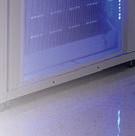
BY SIOBHAN RODRIGUEZ
across the country, not just those at top tech hubs.
“This supercomputer will help level the playing field,” said Suresh Marru, principal investigator of the Nexus project and director of Georgia Tech’s new Center for AI in Science and Engineering (ARTISAN). “It’s designed to make powerful AI tools easier to use and available to more researchers in more places.”
Georgia Tech is building Nexus in partnership with the National Center for Supercomputing Applications at the University of Illinois Urbana-Champaign, which runs several of the country’s top academic supercomputers. e two institutions will link their systems through a new high-speed network, creating a national research infrastructure.
“Nexus is more than a supercomputer—it’s a symbol of what’s possible when leading institutions work together to advance science,” says Charles Isbell, ICS 90, chancellor of the University of Illinois and former dean of Georgia Tech’s College of Computing. “I’m proud that my two academic homes have partnered on this project that will move science, and society, forward.”
Georgia Tech will begin building Nexus this year, with its expected completion in spring 2026.
Nexus is designed to power the most demanding AI research, from curing diseases to understanding how the brain works to engineering quantum materials. Learn what makes it so impressive:
Blazing fast: Over 400 quadrillion operations per second, which is the equivalent of everyone in the world performing 50 million calculations at the same time every second.
Massive brain plus memory: Combines the power of AI and high-performance computing with 330 trillion bytes of memory.
Storage: Features 10 quadrillion bytes of flash storage, equivalent to about 10 billion reams of paper. Stacked, that’s a column reaching 500,000 km high—enough to stretch from Earth to the Moon and a third of the way back.
Supercharged connections: Lightning-fast connections to move data almost instantaneously.
Open to U.S. researchers: Scientists from any U.S. institution can apply to use Nexus.

LEARN WHAT IT TAKES TO APPLY TO BE AN ASTRONAUT FROM TECH’S ASHO s, OR “ASTRONAUT HOPEFULS.”
BY JERRY GRILLO
EEVER SINCE THE 1959 selection of the Mercury Seven astronauts (which included John Glenn and Alan Shepard), NASA periodically puts out the word: We need astronauts. And thousands of dreamers answer the call.
Since 1959, NASA has selected a total of 360 astronauts, 14 of which were Georgia Tech graduates. Right now, fewer than 50 astronauts are active.
Back in 2003, Jud Ready, MatE 94, MS MetE 97, PhD MSE 00, came the closest he’s ever come to making the cut. He was selected as one of the nal 150 candidates out of 4,000 applicants. Comparatively, about 12,000 people applied in 2021, and 10 of them graduated from NASA’s astronaut training program earlier this spring.
For Ready, becoming an astronaut has been a lifelong dream.
DO YOU HAVE WHAT IT TAKES?
Take our unofficial “Astronaut Aptitude Test” at GTalumni.org/AstroTest.

of Tech’s Space Research Institute. “While studying engineering in college, I realized I didn’t want to build the spaceship. I wanted to work inside the spaceship.” Ready applied seven times, becoming part of a group that calls itself “ASHOs” (purposely pronounced much like a common expletive).

Warning: It might be harder than drownproofing.
“From first grade forward, that’s what I planned to do,” says Ready, principal research engineer at the Georgia Tech Research Institute and the inaugural director
“It stands for ‘Astronaut Hopefuls,’ and it’s a very large group,” says Ready.
Throughout the space program’s history, ASHOs have far outnumbered astronauts. But there wouldn’t be astronauts without ASHOs. And there’s something to be said for giving it the old college try. In March, NASA opened the astronaut application process for six weeks. More than 8,000 people applied for eight to 12 astronautcandidate positions. At least three of them come from the Georgia Tech community.




RICHARD AGBEYIBOR

Flight test engineer, U.S. Air Force Third-year PhD student, robotics
Born in Togo, West Africa, Agbeyibor came close to being chosen when he applied in 2020. He was invited to Houston’s Johnson Space Center for an in-person interview in March 2021, “and got the VIP tour, got to hang around with astronauts,” he said. He was invited to a second interview a few months later and was one of the final 30 candidates before being cut.
“This time, if I make it past the resume shuffle to the interview round again, I hope to show that I’ve got the right stuff,” says Agbeyibor, whose family came to the U.S. as refugees when he was 12. After graduating from MIT, where he was in the ROTC program, he was commissioned as an Air Force officer. In 2022, Agbeyibor began his PhD studies, joining the lab of Karen Feigh, AE 01, PhD IE 08, in the Daniel Guggenheim School of Aerospace Engineering.
He’s earned his commercial pilot’s license and is currently pursuing his helicopter license. “I love everything that flies, and flying helicopters has been a dream of mine,” he said, noting too that NASA uses helicopters for training astronauts in Moon landings.



Second-year PhD student, aerospace engineering


CATHERINE SCHLABACH, AE 23, MS AE 24
Second lieutenant, astrospace engineer, U.S. Space Force

At the age of 10, Schlabach watched the space shuttle Atlantis blast off into the Florida sky for the last-ever shuttle mission. She remembers thinking, “Well, they’re not doing this anymore, so there goes my chance to be an astronaut.’ I was really kind of sad.” It was July 2011. She bounced back. Encouraged by an elementary school teacher to focus on STEM subjects and inspired by her grandfather, who flew for the Army Air Corps in World War II, Schlabach felt destined for flight from an early age. She earned her pilot’s license while still in high school. At Tech, she joined the Yellow Jacket Flying Club, and later, the ROTC program, which changed the trajectory of her career.
After earning her master’s, Schlabach moved to Vandenberg Space Force Base in California, where she works in the SpaceX program—she is one of the engineers responsible for managing technical and operational aspects of a rocket launch. “I love being part of the team that’s getting something into space. A big reason I joined the military is for the teamwork and leadership experience—you don’t send just one person; you send a team,” Schlabach says. She is still focused on becoming an astronaut and plans on applying again and again.


Growing up in Melbourne, Florida, Garoust watched launches from Kennedy Space Center a few miles away, daydreaming about riding in one of those rockets. Garoust began checking off the proverbial boxes early. She threw herself into schoolwork, becoming valedictorian in her high school, where she was also captain of the basketball, cross-country, and track teams. She went skydiving. These days, she lifts weights, does yoga, and keeps tabs on current space news.

After graduating from the University of Florida, she joined Koki Ho’s lab in the Guggenheim School, where her PhD focus is on orbital mechanics and optimization. “It’s a lot of fancy space math, basically,” Garoust explains. “I don’t expect much to come out of the astronaut application, not the first time. But I’m eager to apply again because I think my odds will improve each time. I’m just ready to see what life has in store for me.”



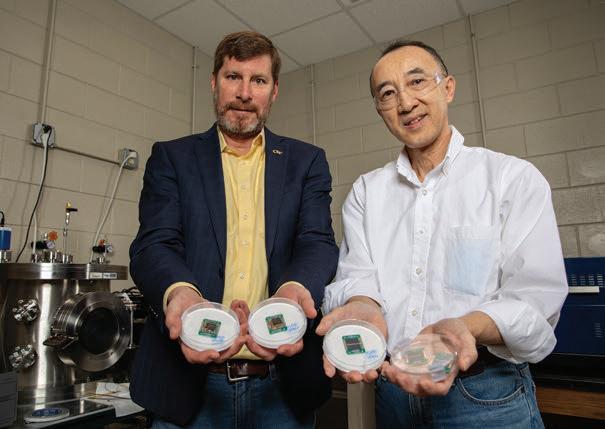
BY JENNIFER HERSEIM
opportunity to work with Professor Stuart Stock, a di raction expert, on a project studying gallium arsenide crystals from the space shuttle. “ is was 1994 and for a kid who wanted to be an astronaut, to now be literally touching something that had been in outer space and analyzing it, that was pretty cool,” he says.
EVERY TIME YOU USE GPS , visit an ATM, or swipe a credit card, you’re using space technology. “Most people don’t realize the technology they use almost every minute of their lives has some connection to space,” says Triple Jacket Jud Ready.
Ready, MatE 94, MS MetE 97, PhD MSE 00, has a special appreciation for space-related innovations as a principal research engineer on the research faculty of the Georgia Tech Research Institute and the inaugural director of Tech’s Space Research Institute (SRI), which launched this summer. SRI is an interdisciplinary hub for all things space-related, and Ready plans to bring Tech to new heights, literally.
“I want Georgia Tech to be the first university to put a student in space,” Ready says. “Not just as a tourist, but as an actual space ight ‘participant’ conducting research, STEM outreach, or writing an article for the Technique.”
It’s not such a far-out idea considering Tech’s achievements. Georgia Tech is the only higher ed institution to own and operate its own interplanetary spacecraft, the Lunar Flashlight. It’s one of four universities in NASA’s Deep Space Network. And, oh yeah, Tech has produced 14 astronauts.
SRI will bring faculty, sta , and students together across a range of disciplines who share a common interest in space exploration and discovery. Some of these groups include the Center for Relativistic Astrophysics, Hypersonics@GT, Astrobiology, and the Center for Space Policy and International Relations.
e new institute will also build on Tech’s rich history of providing students with hands-on learning opportunities. While a student at Tech, Ready remembers having the
Today, Tech researchers are studying materials that are critical for missions to the Moon and to Mars. This past April, they launched the first of two satellites with the goal of improving research into space domain awareness. The satellites that comprise the OrCa2 mission, led by Brian Gunter of the Space Systems Design Laboratory, have special re ective panels that allow ground and space-based telescopes to observe and track them, which can improve general tracking capabilities for orbiting objects. e second satellite is set to launch later this fall. Tech researchers will also lo more than a dozen solar cells using di erent GTgrown photoabsorbers for exposure on the Multi-purpose International Space Station Experiment (MISSE-21). Next year, Tech will send more than two dozen materials samples for space-weathering experiments on MISSE-22, and they’ll send commercially manufactured perovskite-based solar cells to the Moon through a partnership with Qcells, a global solar cell producer with facilities in Georgia. On the curriculum side, the College of Sciences launched a major and minor in Astrophysics and a minor in Astrobiology.
“For thousands of years we’ve been looking to the sky above to try and understand the complexity of what is outside of our world,” Ready says. “ ere are literally an in nite amount of mysteries to be solved in space, and Georgia Tech wants to tackle those challenges and move beyond Earth.”
Join Jud Ready and the Alumni Association on top of the Coda Building this Homecoming, Oct. 23, for a curated stargazing event. Visit GTalumni.org/Homecoming.

GEORGIA TECH PLAYED A ROLE IN THE RECENT DISCOVERY OF THE RARE COSMIC EVENT.
OBSERVATORY (LIGO) has detected an unusual binary black hole merger—a phenomenon that occurs when two black holes are pulled into each other’s orbit and combine. This is the largest ever detected with gravitational waves, according to a paper published by the LIGO-Virgo-KAGRA collaboration.
Tech researchers played a key role on the team that made the discovery and the team that confirmed the detections.
Before merging, both black holes were spinning exceptionally fast, and their masses fell into a range that should be very rare—or impossible.
“Most models don’t predict black holes this big can be made by supernovae, and our data indicates that they were spinning at a rate close to the limit of what’s theoretically possible,” saysMargaret Millhouse, a research scientist in Tech’s School of Physics who played a key role in the research. “Where could they have come from? It raises interesting questions.”
A binary black hole merger absorbs

characteristics from both of the contributors. “As a result, this is not only the most massive binary black hole ever seen but also the fastest-spinning binary black hole con dently detected with gravitational waves.”
“GW231123 is a record-breaking event,” says School of Physics Professor Laura Cadonati,who has been a member of the LIGO Scientific Collaboration since 2002. “ is discovery underscores that there is still so much that this instrument can help us learn.”
e ndings challenge current theories on how smaller black holes form, says School of Physics Assistant Professor and LIGO collaborator Surabhi Sachdev. Smaller black holes are the result of supernovae: dying and collapsing stars. During that collapse, explosions can tear apart or eject part of the star’s mass—limiting the size of the black hole that forms. “Black holes from supernovae can weigh up to about 60 times the mass of our Sun,” she says. “The black holes in this merger were likely the mass of hundreds of suns.”
DECODING A SPLITSECOND SIGNAL
Millhouse and School of Physics
BY SELENA LANGNER

postdoctoral fellow Prathamesh Joshi used Einstein’s equations for general relativity to confirm LIGO’s detections. To nd black holes, LIGO measures distortions in spacetime— ripples that are created when two black holes collide.
“In this case, the signal lasted for just one-tenth of a second, but it was very clear,” says Joshi. “Previously, we designed a special study to detect these interesting signals, which accounted for all the unusual properties of such massive systems—and it paid o !”
“To ensure it wasn’t noise, the Georgia Tech team first reconstructed the signal in a model-agnostic way,” Millhouse adds.
“We then compared those reconstructions to a model that uses Einstein’s equations of general relativity, and both reconstructions looked very similar, which helped confirm that this highly unusual phenomenon was a genuine detection.”
GW231123 could provide clues on how larger black holes are formed, including the mysterious supermassive black holes at the center of galaxies.
“Gravitational wave science is almost a decade old, and we’re still making fundamental discoveries,” says Millhouse.

Georgia Tech has achieved the most successful fundraising year in its history, raising nearly $300 million in philanthropic support in Fiscal Year 2025. This achievement marks a significant milestone for the Institute. More than 25,000 donors contributed to this year’s success — including alumni, foundations, corporations, and first-time supporters.
This monumental success marks a 20% increase over the Institute’s previous record-setting year and fuels momentum for Transforming Tomorrow: The Campaign for Georgia Tech, the most ambitious philanthropic e ort in the Institute’s history, which now totals $1.601 billion and counting as of July 30, 2025. Fiscal Year 2025 places Georgia Tech on pace to achieve its $2 billion campaign goal by the end of 2027.
This record-breaking year reflects major investments in strategic priorities, including the launch of the Invest in the Best Scholarship Challenge, where donors unlocked $100 million in new endowed scholarship support for low- and limited-income students, thanks to a dollar-for-dollar match from the Georgia Tech Foundation. The challenge has created 90 new scholarships and expanded the reach of 40 existing funds, doubling donor impact and expanding opportunities across campus.
Highlights of philanthropy at work across campus include:
The College of Computing has reached an agreement with South Korean games company Nexon to create a new cybersecurity research hub.
The MapleStory Security Research Fund (named after one of Nexon’s biggest games) will support research into cybersecurity for massive multiplayer online role-playing games. Nexon currently operates over 80 live games in 100 countries.
The hub will be led by Professor Taesoo Kim and located in the School of Cybersecurity and Privacy. The $600,000 grant will fund supplies, equipment, travel to conferences, and other research expenses.
“The MapleStory Security Research Hub at Georgia Tech represents a transformative step in securing the digital entertainment ecosystem,” said Michael Bailey, school chair in Cybersecurity and Privacy. “Online gaming is a microcosm of cybersecurity challenges faced across industries — from protecting vast user communities to mitigating evolving threats in complex online environments.”
To learn more or to make a gift to cybersecurity research, contact Jason Zwang, senior director of Development, College of Computing, at jason.zwang@cc.gatech.edu.
Biomedical engineers have created a treatment that could one day unlock a universal strategy for treating some of the hardestto-treat cancers — like those in the brain, breast, and colon — by teaching the immune system to see what it usually misses.
In lab tests, the therapy didn’t damage healthy tissues, and it stopped cancer from returning. While still in early stages of development, the treatment builds on well established technologies, giving it a clearer, quicker path to clinical trials and patient care.
The technique developed by Gabe Kwong, Robert A. Milton Chair and associate professor in the Wallace H. Coulter Department of Biomedical Engineering, is a one-two punch. First, it flags tumor cells. Then specially enhanced T cells from the patient’s own immune system recognize and eliminate the disease.
Marking tumors this way o ers a potential path to treating cancers without the targets that drugs typically go after, giving options to patients who often don’t have many.
To support innovative faculty research in the College of Engineering, contact David Zaksheske, senior director of Development, at davez@coe.gatech.edu.



Georg Reichard has been named the new chair of Georgia Tech’s School of Building Construction, e ective July 1. He joins the College of Design from Virginia Tech, where he was a professor and head of the Department of Building Construction and the associate director of Operations in the Myers-Lawson School of Construction.
“Georg Reichard brings a wealth of experience to the School and the College. I am particularly excited to collaborate with him on expanding our undergraduate program, strengthening our links to Atlanta’s vibrant construction and real estate development industry, and expanding our important applied research portfolio,” said Ellen Bassett, dean and John Portman Chair of the College of Design.
“Construction 4.0, a key part of the Fourth Industrial Revolution, is unfolding before our eyes and being embraced by stakeholders across the board. It’s our moment to lead, innovate, and redefine the future of building,” Reichard said.
To support Georg Reichard’s vision for the School of Building Construction, contact Kelly Smith, director of Development, College of Design, at kelly.smith@design.gatech.edu.
The Southern Company Foundation awarded a $2.5 million grant to the Georgia Tech Center for Urban Research to support Mayor Andre Dickens’ e ort to address socioeconomic inequities in Atlanta neighborhoods.
“This investment is a major step forward in Mayor Dickens’ e ort to improve the quality of life of all Atlantans,” said David Edwards, the founding executive director of the Center for Urban Research and policy advisor for neighborhoods in the City of Atlanta O ce of the Mayor.
The Center, housed in the Jimmy and Rosalynn Carter School of Public Policy, is a collaboration between Georgia Tech and the mayor’s o ce. It brings together university, community, nonprofit, and municipal leaders to develop and evaluate solutions that address inequities in urban centers. Current projects include neighborhood improvement plans and climate-oriented engineering for housing and facilities on public land.
The Center will use this grant to evaluate and inform the mayor’s “Achieving Fairness of Place” initiative, which is investing in seven historically disinvested neighborhoods to improve outcomes in housing, education, health, and economic mobility.
To learn more or to make a gift to the Center for Urban Research, contact Lauren Kennedy, director of Development in the Ivan Allen College of Liberal Arts, at lauren.kennedy@dev.gatech.edu.
The College of Lifetime Learning welcomed Bill Gaudelli as their inaugural dean, e ective Aug. 1. Gaudelli brings more than 35 years of experience as an educator, researcher, and academic administrator to this role. An internationally recognized scholar on global citizenship education and teacher development, he has authored more than 85 scholarly works, including several books on the topic of teaching and learning through a global lens.
The College of Lifetime Learning, established in September 2024, is Georgia Tech’s seventh College and its first in more than three decades. It houses the Center for 21st Century Universities; the Center for Education Integrating Science, Mathematics, and Computing; Georgia Tech Professional Education; and Georgia Tech-Savannah. The College seeks to transform how individuals learn across their lifetimes and how organizations provide access to reskilling and upskilling. With a focus on providing accessible, a ordable, and transformative opportunities, it serves groups across the spectrum of learning, including K-12 students, working professionals, and lifelong learners.
Philanthopy will expand the College of Lifetime Learning’s educational o erings, support life-changing research, and drive societal impact. To make a gift to the Dean’s Excellence Fund in the College of Lifetime Learning, contact Ashley Coogan, assistant vice president for Unit Development, at ashley.coogan@dev.gatech.edu.




The College of Sciences named Jenny McGuire as the first recipient of the Harry and Anna Teasley Professorship in Ecology. The newly endowed faculty position supports research and teaching that meaningfully advances the understanding and responsible stewardship of species and community dynamics amid evolving ecological interactions driven by global environmental change. McGuire, an associate professor in the School of Biological Sciences and the School of Earth and Atmospheric Sciences, was selected for her pioneering ecological research and exceptional teaching e orts.
“Jenny’s creative and fundamental research in spatial and community ecology is helping to position Georgia Tech as a leader in biodiversity and ecosystem conservation,” says Todd Streelman, professor and chair of the School of Biological Sciences. “Her appointment continues a trend in the School to award research endowments to our most promising early- and mid-career scientists and highlights the strong support and generosity of alumni such as the Teasley family.
To make a gift in support of promising faculty, contact Dan Warren, director of Development for the College of Sciences, at dan.warren@cos.gatech.edu.


Tremendous progress is underway on Tech Square Phase 3, Georgia Tech’s bold next step in advancing innovation and collaboration. Slated for completion in 2026, the project features the 14-story Scheller Tower and 18-story George Tower, named in honor of benefactors Ernest Scheller Jr., IM 1952, HON Ph.D. 2013, and Bill George, IE 1964, HON Ph.D. 2008, and his wife Penny.
Tech Square Phase 3 will house Scheller College of Business graduate and executive education programs and the H. Milton Stewart School of Industrial and Systems Engineering. It will serve as a vibrant hub for interdisciplinary collaboration, corporate innovation, and experiential learning.
A partnership between the State of Georgia, Georgia Tech, and philanthropists, this newest development builds on the original Tech Square vision to strengthen the innovation ecosystem in Atlanta and beyond. Opportunities remain to name spaces in Tech Square Phase 3; these gifts provide essential, flexible support to address opportunities and needs.
To name a space in Tech Square Phase 3, contact Duante Stanton, senior director of Development, Scheller College of Business, at duante.stanton@scheller. gatech.edu, or Nancy Sandlin, senior director of Development, Stewart School of Industrial and Systems Engineering, at nancy.sandlin@isye.gatech.edu.
Ryan Alpert, a seasoned collegiate athletics executive and one of the nation’s most respected leaders in revenue generation and athletic operations, was named vice president and director of athletics at Georgia Tech on July 8. Alpert comes to The Flats from the University of Tennessee, where he served as senior deputy athletics director and chief revenue o cer.
At Tennessee, Alpert oversaw business and finance, development, marketing, ticketing, capital projects, sponsorships, and more — collectively helping Tennessee Athletics increase its annual revenue by over $100 million since 2022. In fiscal year 2024 alone, the department generated a record $228 million in operating revenue and raised nearly $140 million through the Tennessee Fund. He also served as the lead on the Neyland Entertainment District, a transformative public-private partnership that is revitalizing Knoxville’s riverfront and enhancing the game-day experience around Neyland Stadium. ATHLETICS

To learn more or to make a gift to Full Steam Ahead, the athletics initiative that is transforming athletic facilities, elevating the game-day experience, and providing resources to compete at the highest level, contact Robby Poteat, executive associate athletics director for Development, at rpoteat@athletics.gatech.edu.

The Georgia Tech Library is hosting a special exhibition highlighting the extraordinary life and work of John C. Portman Jr., ARCH 1950, HON Ph.D. 2012, the visionary architect behind some of Atlanta’s most iconic buildings.
A proud Georgia Tech alumnus, Portman reshaped the city’s skyline with his innovative designs, including the Hyatt Regency and Peachtree Center. This exhibit o ers an exclusive look into Portman’s creative process, architectural achievements, and lasting influence on urban design, featuring artifacts from both the Georgia Tech Archives and Special Collections and the Portman Archives. Explore how Portman’s connection to Georgia Tech helped shape his remarkable career and continues to inspire future generations of architects and designers. The exhibit, located in the gallery in the Price Gilbert Memorial Library, runs through December.
For more information or to make a gift in support of exhibitions like this, contact Heather Howarth, director of Development for the Library, at heather.howarth@library.gatech.edu.





At Georgia Tech, safeguarding freedom of expression and inquiry is one of our strategic values. Through the open exchange of ideas, Georgia Tech students learn to see the world from di erent perspectives, hone their critical thinking skills, and refine their unique viewpoints.
Student Engagement and Well-Being leads the freedom of expression initiative by providing Georgia Tech students with guidelines, education, and support to help them e ectively express their beliefs and values, as well as to listen actively and communicate thoughtfully with others who might have a di erent opinion or worldview. “We emphasize that free speech is a right that also comes with responsibilities as a member of the Yellow Jacket community,” said Luoluo Hong, vice president for Student Engagement and Well-Being.
One helpful resource for students is Perspectives, powered by the Constructive Dialogue Institute. This online course equips students with a useful framework and shared language for engaging in compassionate and caring conversations. Starting in the fall semester of 2025, in compliance with USG policy, the Perspectives course will be mandatory for all new Georgia Tech students.
To support strategic initiatives like this that focus on student engagement and well-being, contact Emily Wong, director of Development, at emily.wong@dev.gatech.edu.

The National Science Foundation has awarded Georgia Tech and partners $20 million to build Nexus, a powerful new supercomputer. Nexus will make state-of-the-art AI infrastructure available to scientists all across the country, not just those at top tech hubs. With blazing speed and massive memory, Nexus can crank out over 400 quadrillion operations per second — the equivalent of everyone in the world continuously performing 50 million calculations every second.It is designed to be easy to use and open to researchers nationwide, enabling scientists to tackle big challenges: developing new medicines, advancing clean energy, driving manufacturing innovations, and understanding the brain.
Construction on Nexus begins this year, with completion expected in spring 2026. Georgia Tech is building Nexus in partnership with the National Center for Supercomputing Applications at the University of Illinois Urbana-Champaign, which runs several of the country’s top academic supercomputers. The two institutions will link their systems through a new high-speed network, creating a national research infrastructure.
Donor support is critical to funding AI-centered innovation at Georgia Tech. To learn more, contact Meagan Burton-Krieger, executive director of Campaign Operations and chief of sta , at meagan.burton-krieger@dev.gatech.edu.

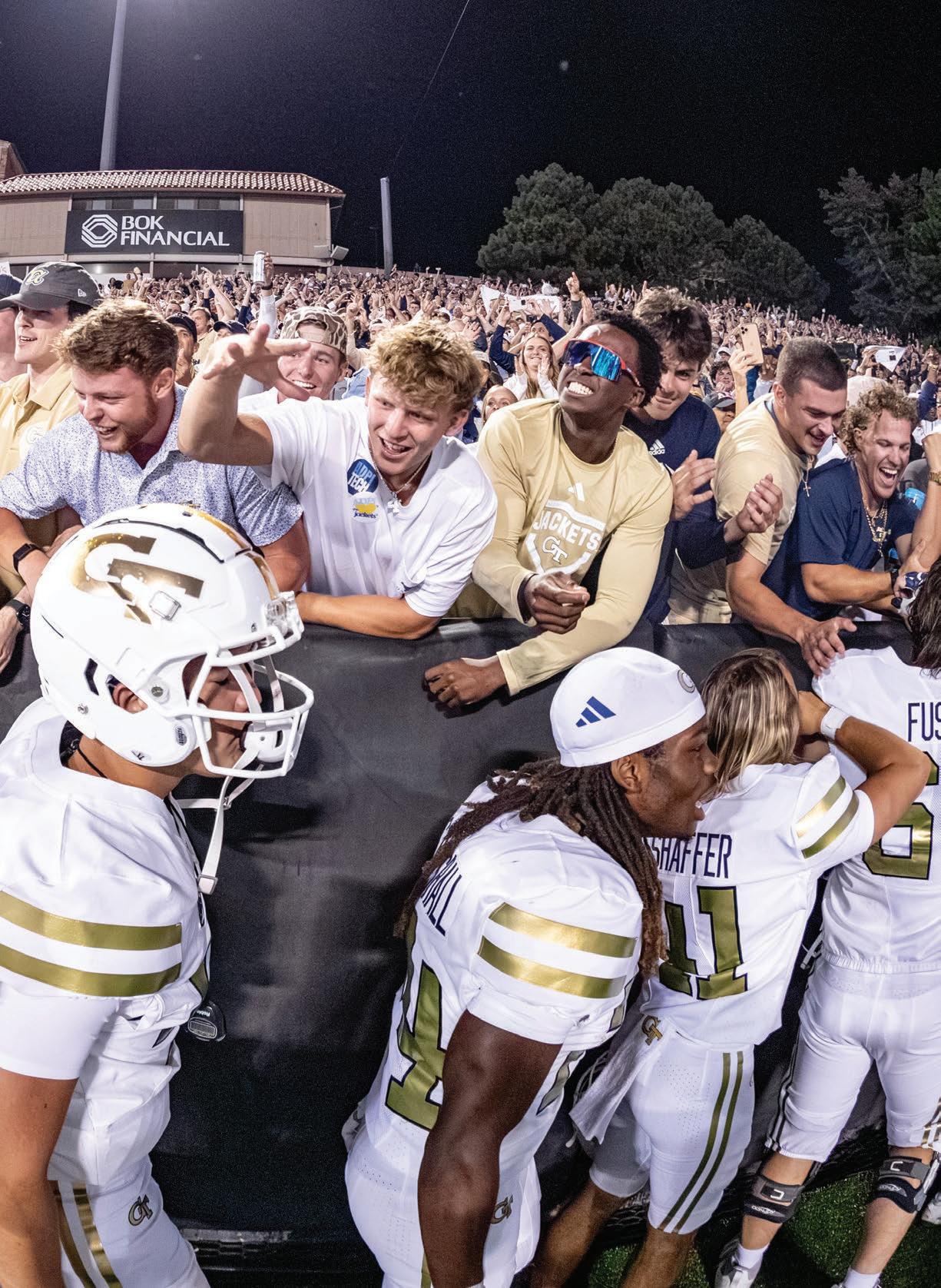
Yellow Jacket fans at Folsom Field in Boulder, Colorado, celebrate with the players after Georgia Tech’s thrilling season opener. The Jackets beat Colorado 27-20, winning on their final offensive play of the game.
BY JENNIFER HERSEIM
BBOBBY DODD’S COACHING SUCCESS on the gridiron cemented his legacy in college football history. It was his actions o the eld, instilling in his players values that would lead to success outside of football, that still inspires coaches, even decades later. is year marks the 50th anniversary of The Dodd Trophy presented by PNC Bank. The national coaching award is named in Dodd’s honor to recognize a successful college coach whose program stresses Dodd’s core values.
“Bobby Dodd had three main pillars that he lived by: scholarship, leadership, and integrity. He wanted his players to be successful long a er the crowd stopped cheering, and so he made sure they graduated,” says Jim Terry, IM 72, chairman of the board













for e Bobby Dodd Coach of the Year Foundation.
e winner of the 2025 trophy will be announced during the Chick- l-A Peach Bowl later this year. is October, Georgia Tech will honor the 50th anniversary of e Dodd Trophy with a series of events, including a special presentation at the Yellow Jackets’ Oct. 11 game against Virginia Tech, which will recognize five former winners



with ties to Georgia Tech: George O’Leary, Paul Johnson, Bobby Ross, Bill Curry, and Ralph Friedgen. The night before, Johnson will be inducted into the Georgia Tech Sports Hall of Fame. The Dodd Trophy will also be on display at the Alumni Association’s Leadership Tailgate.
Unlike other awards, The Dodd Trophy is presented to the winner at their university so that the coach’s players, sta , and family can share the moment. Winning e Dodd Trophy is often the highlight of a coach’s career. “It stands for more than just winning football games, although that’s important. It means you did it with integrity,” Terry says.
Dodd was hired in 1930 as a backfield football coach under William Alexander and replaced Alexander as Tech’s head coach in 1945. Over the next 22 years, Dodd led the Yellow Jackets to 13 bowl games with nine bowl game victories, a 165-64-8 record, and a national championship in 1952. In 1959, he was elected to the College Football Hall of Fame, and he’s one of only a few to be inducted as both a player and a coach (inducted in 1993). In 1966, he retired as Tech’s head coach, but stayed at Tech for another nine years as athletic director. He remained connected to Tech until his death in 1988 at 79 years old. In addition to The Dodd Trophy, Dodd’s legacy carries through the Bobby Dodd Institute, an organization that supports individuals with disabilities and their families, as well as the Bobby Dodd Memorial Golf Tournament and Bobby Dodd Stadium at Georgia Tech.

PAST RECIPIENTS OF THE DODD TROPHY FROM GEORGIA TECH
1989 Bill Curry (Received while at the University of Alabama)
1990 Bobby Ross, Georgia Tech
2000 George O’Leary, Georgia Tech
2001 Ralph Friedgen (Received while at the University of Maryland)
2004 Paul Johnson (Received while at the U.S. Naval Academy)





EIGHT YELLOW JACKETS represented Tech on national volleyball teams. Junior setter Heloise Soares earned a gold medal on the U23 Brazilian National team in the Pan American Games while junior right side Larissa Mendes represented the green and gold’s U21 National team in the World Championships, earning a bronze medal. Senior Sofia Velez is set to train with the Colombian Senior Team for the World Championships. The Polish National Team included two of Tech’s newest Jackets: Gabriela Robinska, who played on the U19 team, and Anna Fiedorowicz, who played on the U21 team, both competing in the World Championships. Tech’s newest setter, Sara Toth, joined the CEV Volleyball Golden European League Roster, representing Hungary. Incoming outside hitter Lameen Mambu represented Tech on the U.S. U19 National Team in the World Championships. Transfer Bianca Garibaldi competed on the U21 Argentinian National Team in the World Championships while All-American alumna Bianca Bertolino, Bio 25, represented Argentina on the World Championship Senior Team. Mariana Brambilla, Psy 21, was selected for the U26 Brazilian National Team.
GEORGIA TECH ATHLETICS
ON JULY 16, RYAN ALPERT, a seasoned collegiate athletics executive, joined Georgia Tech as its new vice president and director of athletics. Previously, Alpert served as senior deputy athletics director and chief revenue o cer at the University of Tennessee, Knoxville. Alpert brings nearly two decades of leadership experience across the Southeastern Conference and beyond, with a track record of success in fundraising, capital project management, external a airs, and strategic planning.
“Ryan Alpert is a dynamic, forwardthinking leader who understands what it takes to build a winning culture on a strong nancial foundation. He brings deep operational expertise and a clear passion for student-athlete development,” says Georgia Tech President Ángel Cabrera, MS Psy 93, PhD Psy 95.
At Tennessee, Alpert played a central role in the Volunteers’ rise to national prominence across multiple sports. He helped lead the department to its highest-ever finish in the Learfield Directors’ Cup and to three consecutive SEC All-Sports Championships. As a senior executive, he oversaw business and finance, development, marketing, ticketing, capital projects, sponsorships, and more, collectively helping Tennessee Athletics increase its annual revenue
by over $100 million since 2022. In scal year 2024 alone, the department generated a record $228 million in operating revenue and raised nearly $140 million through the Tennessee Fund. Alpert also served as the lead on the Neyland Entertainment District, a transformative public-private partnership that is revitalizing Knoxville’s riverfront and enhancing the gameday experience around Neyland Stadium.
“As college athletics continues in a period of rapid transformation, I’m excited about all the Institute has to o er and what we can accomplish together. Tech’s visionary leadership, combined with its world-class academics and commitment to competitive excellence, provides a strong foundation for the future,” Alpert says.
Alpert’s previous roles include deputy athletic director at the University of Missouri and Florida Atlantic University. He also served in development and leadership positions at the University of Memphis. Originally from Columbia, South Carolina, he holds a bachelor’s from the University of South Carolina and a master’s from the University of Memphis. He and his wife, Rebecca, have two daughters, Mary Margaret and Annie.
GEORGIA TECH ATHLETICS
JAMES RAMSEY, who has orchestrated some of college baseball’s most prolific offenses and recruiting classes over the last seven seasons, has been named the 13th head coach in Georgia Tech baseball history.
Ramsey, who joined Tech baseball’s staff in 2019 as an assistant coach and was named associate head coach in 2021, replaces legendary head coach Danny Hall, who stepped away as the ninth-winningest head coach in college baseball history following the conclusion of the 2025 season.


In seven seasons since Ramsey’s arrival on e Flats as hitting coach in 2019, Georgia Tech leads the ACC in batting average, hits, doubles, on-base percentage, OPS and sacri ce ies, and ranks second in runs, triples, home runs, RBI and slugging percentage. Since he took over as the Yellow Jackets’ recruiting coordinator following the 2019 season, Tech has landed four top-5 and ve top-10 signing classes, and all six have ranked among the top 20 nationally. Most recently, Ramsey was an integral part of Tech’s run to the 2025 ACC regular-season championship, Tech’s rst since 2011.
Ramsey’s coaching success has come on the heels of an ultra-successful playing career. As a four-year letterwinner and three-year starter in the out eld at Florida State (2009–’12), Ramsey was
the 2012 ABCA Player of the Year and the ninth consensus All-American in FSU history.A team captain as a senior, he was named the 2012 ACC Player of the Year and capped his college career with a fourth-consecutive ACC Atlantic Division title, a trip to the College World Series, a pair of victories in Omaha, and a No. 4 nal national ranking. Ramsey was selected in the first round of the 2012 Major League Baseball Draft by the St. Louis Cardinals (No. 23 overall). He played seven professional seasons with the Cardinals, Cleveland Guardians, Los Angeles Dodgers, Seattle Mariners, and Minnesota Twins organizations. He was selected to participate in the MLB All-Star Futures Game in 2014 and helped lead the Columbus Clippers to the 2015 International League championship.
“Tech is such a special place to me and my family. To be entrusted to take the torch from Coach Hall—one of the greatest coaches in the history of our sport—and lead this program is the opportunity of a lifetime,” Ramsey says. He graduated from Florida State in 2012. An Alpharetta, Ga. native, Ramsey and his wife, Grace, BA 12, a former Georgia Tech cheerleading captain, have two children, Brogan and Reese.




GEORGIA TECH WOMEN’S BASKETBALL alumna Danielle Donehew, IE 01, was officially inducted into the Women’s Basketball Hall of Fame June 14 at the Historic Tennessee Theatre in Knoxville, Tenn. Donehew, the current Women’s Basketball Coaches Association executive director, was one of seven members inducted.
A four-year letterwinner at Georgia Tech (1996–’00), Donehew left her mark as a Yellow Jacket on and off the court. She helped Tech to a WNIT postseason appearance, while setting the program record with eight three-pointers in a game twice and still owns the record for three-pointers made in a single season with 86 in 1998–’99. She was a two-time academic all-ACC and CoSIDA academic all-district, and was awarded the ACC Postgraduate Scholarship in 2001. In 2013, Donehew was selected as Georgia Tech’s ACC Legend.
Donehew has dedicated her career to furthering the game of women’s basketball and is currently the longest serving leader of the major women’s basketball stakeholder positions. She has worked at both the collegiate and professional levels as she was executive vice president of the Atlanta Dream.
GEORGIA TECH ATHLETICS

COOL YELLOW JACKETS
Margaret Milikin, ID 00, bikes past ski-equipped LC-130s at McMurdo Station in Antarctica. At the station, scientists conduct research, including studies on how humans work and live in isolated environments, important for interplanetary exploration.



KELLEY FREUND
CCULLEN WELCH, IE 13, was just 6 years old when he saw a map of Antarctica. The big continent at the bottom of the world intrigued him, but what he didn’t know yet was that an entire community existed there. McMurdo Station at its summer peak is home to a little over 1,000 residents working in the name of scienti c research ranging from astrophysics to geology. And for four Tech grads who crave exploration and the chance to work outside, it’s the perfect place to do just that.
All four alumni eventually found
themselves working in Antarctic Terminal Operations (ATO), which is responsible for all cargo and personnel movements at McMurdo. Welch started out his time in Antarctica transporting people to and from the airfields and the Long Duration Balloon facility, a NASA-sponsored facility about five miles out on the ice shelf. Welch is currently the only ice-cold Yellow Jacket, spending the very dark winter season at McMurdo Station transporting people and cargo, serving on the search and rescue team, and participating in a NASA study regarding the effects of no sunlight on the human brain. The findings
will be useful for future long-duration space ights.
Welch and three fellow Yellow Jackets landed gigs at ATO by taking paths not normally traversed by a typical Tech grad. Welch spent time as an underwater scuba photographer and sailed across the Atlantic Ocean in a sailboat. Margaret Milikin, ID 00, worked in Alaska and later for the National Park Service. Ethan Gehl, CE 08, hiked the Pacific Crest Trail and rode a bike across the country while volunteering for affordable housing organizations. And Ian Adams, ME 19, worked as a commercial sherman and a wilderness guide.
“THE
Milikin, who is preparing for her 13th season in Antarctica, reached the bottom of the world rst and jokes that she waited years for another Tech grad to show up. That alum was Gehl in 2022, followed by Welch in 2023, and Adams in 2024.
For Milikin, one of the best parts about her job as the airfield shift supervisor for cargo is working with the airplanes that y into Antarctica. e air elds that service McMurdo are actually on the continental ice shelf, which means if you were to drill down 80 feet, you’d get to the ocean. The planes include Boeing C-17s; ski-equipped LC-130s, of which there are only about 10 currently in service for use in Greenland and Antarctica; smaller aircra known as Twin Otters that travel to eld sites that don’t have a full runway; and Baslers, which are modernized C-47 Skytrains from World War II. (One of these Basler airframes actually dropped paratroopers into Europe during Operation Market Garden in World War II.)
Welch now transports cargo at ATO, as did Gehl and Adams during their stints in Antarctica. e job involves the use of heavy equipment, including a modi ed mining dump truck out tted with balloon tires to drive over the ice, to get cargo o and on the planes. But as the coldest, driest, and windiest continent on Earth, Antarctica
is not a place where machinery was meant to survive. Milikin says the cargo team is constantly trying to make sure their equipment is functioning, and that means sometimes being resourceful. Milikin once had to draw up welding plans herself to get something repaired.
“I think something that would surprise people to know about McMurdo is that it’s full of artist-like people,” says Milikin. “ ere’s an immense amount of creativity that flows out of a place with limited resources and supplies.”
While Welch is in Antarctica now, Gehl is currently working in Alaska, bartending on the Wilderness Express, a tourist train that runs between Anchorage and Fairbanks. Adams works at the Alaska Volcano Observatory as a warehouse manager, with hopes to transition to field engineer, which would combine his love of engineering with being outdoors. And Milikin has a seasonal job with the National Park Service.
Living conditions in Antarctica are di cult. And yet Milikin is preparing to return later this year. And in 2026, Welch will be headed to the South Pole for nine months. Why return to such a challenging place every year? For Welch, he likes to know he’s part of something bigger than himself.
“We are supporting science and the frontier of human exploration,” he



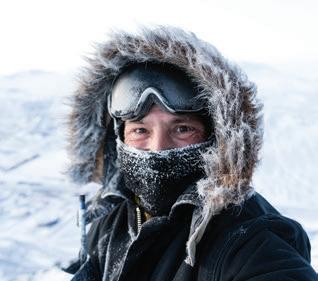

says. “The ATO department that we all worked for exists because scientists need to deploy to the near- and deepfield of Antarctica for important research with global and interplanetary impacts. The next step beyond Antarctica is to the stars. All of that feels deeply compelling and inspiring.”

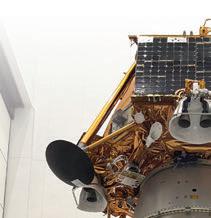




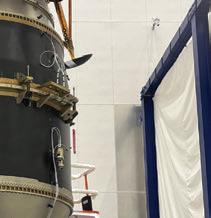

FIREFLY AEROSPACE MADE HISTORY AS THE FIRST COMMERCIAL COMPANY TO MAKE A LUNAR LANDING. MEET THE ENGINEER WHO DIRECTED THE MISSION.
COLLEEN M c NALLY ARNETT
Zuberi joined Firefly in 2021. Her celestial aspirations trace back to childhood, when her father o en took her to visit NASA’s Johnson Space Center. She chose Tech for its top-ranked Aerospace Engineering program.


FFARAH ZUBERI, AE 12 , in her role as director of Spacecra Mission Management at Firefly Aerospace reached new heights in March 2025 when the Blue Ghost lunar lander successfully touched down on the Moon.
Part of NASA’s Commercial Lunar Payload Services initiative, the 14-day mission achieved many firsts: tracking GPS signals on the Moon, robotically drilling and collecting data from deeper in the lunar surface than ever before, and capturing high-de nition imagery of a total solar eclipse—ultimately paving the way for future exploration. Like its namesake (a rare Blue Ghost lightning bug from Southern Appalachia), the science behind the lunar lander is mystifying and hard to grasp. is is where Zuberi comes in. As the
director, she is responsible for ensuring customer satisfaction across multiple payloads and leading di erent subsystem teams to make them all happen. One day, she is helping the Structures & Mechanisms team design a robotic arm. Next, she is supporting the Propulsion & Guidance, Navigation, and Control teams to capture an image during a critical burn. Another day, she is involved closely with the Thermal Control Substance team on heat conductance. She was on console at 2:34 a.m. on Sunday, March 2, when the Blue Ghost touched down. “I had several dreams about landing on the Moon, and I would get upset when I would wake up and that wasn’t reality. en, it actually happened and it was so much better than all of the dreams.”
Farah Zuberi (far right) and Allen Butler (far left) with Blue Ghost, which is integrated with the launch vehicle payload adapter.
After a short celebration, it was back to work. “You only get so much time to do everything you want to do before your spacecraft becomes nonoperational,” she adds. “For me the job wasn’t done, it was just beginning.” e 14 days that followed included long hours, late nights, and many sacri ces. “It’s hard to sleep and hard to not be at work when you’re doing something on the Moon,” she recalls.
Still, some of the most critical lessons came outside of the classroom. Zuberi studied abroad in France, interned at NASA, and captained the Goldrush dance team. at ability to choreograph a team—all while juggling a di cult course load—parallels the leadership skills required to direct 10 payloads at once. “Georgia Tech taught me a lot about time management, setting goals, and skills that weren’t even technical. It helped me succeed in ways I didn’t really expect.”
That also includes forming a network of fellow alumni within Firefly, like Allen Butler, AE 16, the director of Spacecraft Integration, Test and Launch Operations, and Robby Ainsworth, AE 16, who serves as an Assembly, Integration and Test Engineer on the Blue Ghost team.
More Blue Ghost voyages are planned, including a $176.7 million contract from NASA to deliver five payloads to the Moon’s south pole in 2029. “Whatever we learn is impacting the decisions that will be made for humans returning on the Moon,” Zuberi says. It’s a goal that keeps her shooting for the stars.









FIREFLY AEROSPACE MADE HISTORY AS THE FIRST COMMERCIAL COMPANY TO MAKE A LUNAR LANDING. MEET THE ENGINEER WHO DIRECTED THE MISSION.
COLLEEN M c NALLY ARNETT
Zuberi joined Firefly in 2021. Her celestial aspirations trace back to childhood, when her father o en took her to visit NASA’s Johnson Space Center. She chose Tech for its top-ranked Aerospace Engineering program.


FFARAH ZUBERI, AE 12 , in her role as director of Spacecra Mission Management at Firefly Aerospace reached new heights in March 2025 when the Blue Ghost lunar lander successfully touched down on the Moon.
Part of NASA’s Commercial Lunar Payload Services initiative, the 14-day mission achieved many firsts: tracking GPS signals on the Moon, robotically drilling and collecting data from deeper in the lunar surface than ever before, and capturing high-de nition imagery of a total solar eclipse—ultimately paving the way for future exploration. Like its namesake (a rare Blue Ghost lightning bug from Southern Appalachia), the science behind the lunar lander is mystifying and hard to grasp. is is where Zuberi comes in. As the
director, she is responsible for ensuring customer satisfaction across multiple payloads and leading di erent subsystem teams to make them all happen. One day, she is helping the Structures & Mechanisms team design a robotic arm. Next, she is supporting the Propulsion & Guidance, Navigation, and Control teams to capture an image during a critical burn. Another day, she is involved closely with the Thermal Control Substance team on heat conductance. She was on console at 2:34 a.m. on Sunday, March 2, when the Blue Ghost touched down. “I had several dreams about landing on the Moon, and I would get upset when I would wake up and that wasn’t reality. en, it actually happened and it was so much better than all of the dreams.”
Farah Zuberi (far right) and Allen Butler (far left) with Blue Ghost, which is integrated with the launch vehicle payload adapter.
After a short celebration, it was back to work. “You only get so much time to do everything you want to do before your spacecraft becomes nonoperational,” she adds. “For me the job wasn’t done, it was just beginning.” e 14 days that followed included long hours, late nights, and many sacri ces. “It’s hard to sleep and hard to not be at work when you’re doing something on the Moon,” she recalls.
Still, some of the most critical lessons came outside of the classroom. Zuberi studied abroad in France, interned at NASA, and captained the Goldrush dance team. at ability to choreograph a team—all while juggling a di cult course load—parallels the leadership skills required to direct 10 payloads at once. “Georgia Tech taught me a lot about time management, setting goals, and skills that weren’t even technical. It helped me succeed in ways I didn’t really expect.”
That also includes forming a network of fellow alumni within Firefly, like Allen Butler, AE 16, the director of Spacecraft Integration, Test and Launch Operations, and Robby Ainsworth, AE 16, who serves as an Assembly, Integration and Test Engineer on the Blue Ghost team.
More Blue Ghost voyages are planned, including a $176.7 million contract from NASA to deliver five payloads to the Moon’s south pole in 2029. “Whatever we learn is impacting the decisions that will be made for humans returning on the Moon,” Zuberi says. It’s a goal that keeps her shooting for the stars.


Rooted in Atlanta, Veracity Capital helps Yellow Jackets grow, protect, and preserve their wealth.
Rooted in Atlanta, Veracity Capital helps Yellow Jackets grow, protect, and preserve their wealth.
Co-founded by a Georgia Tech alum, we combine ingenuity and determination to engineer financial plans as bold as your ambitions.
Co-founded by a Georgia Tech alum, we combine ingenuity and determination to engineer financial plans as bold as your ambitions.
Connect with us to align your wealth with what matters most.
Connect with us to align your wealth with what matters most.



BUSINESS
ASSESSING INNOVATION: METRICS, RUBRICS, AND STANDARDS
MELINDA (ROSS) TOURANGEAU, EE 88
In this unique technical manual, Tourangeau shows the reader how to quantify innovation through metrics, rubrics, and standards. By considering the human element, this book introduces a fresh new perspective that not only helps in the assessment of innovation levels but also lays the groundwork for how to sustain innovation and advancement in professional industries, academia, the government, and the military.


RADIATION: AN ANTHOLOGY OF DEFINING STORIES
JOHN JOHNSON, ME 59, AND A.B. AMIS III, EE 52
Johnson and Amis co-authored Radiation: An Anthology of Defining Stories, the story of a small, high-tech company that became a key contractor to the government in the early space age and during the darkest days of the Cold War. Starting with virtually nothing in 1950, it is now one of the largest defense contractors in the country. Along the way, it turned a small Florida town into a major industrial hub.



MYSTERY
MUZZLE THE BLACK DOG
MIKE COBB, CHEM 75, PHD CHEM 80
Cobb’s newest psychological thriller promises to probe the deepest recesses of the reader’s mind. After a mysterious stranger appears at the door of Jack Pate’s isolated North Carolina cabin and delivers a cryptic message, Jack is thrust on a cataclysmic collision course with a dark and powerful force that has been lurking in the shadows.


THE FIVE REALMS
RYAN KIESSHAUER, STC 03
Kiesshauer published the final book in his first fantasy trilogy, The Five Realms. As the companions come full-circle, evil takes new and darker forms, and yet hope remains. Is there enough light left in the five realms to face down the coming dark?


FIRE ISLAND MODERNIST: HORACE GIFFORD AND THE ARCHITECTURE OF SEDUCTION
CHRISTOPHER RAWLINS, ARCH 95
Rawlins is celebrating the release of an expanded edition of his best-selling 2013 book. This edition showcases the underappreciated artistry of Gifford’s “gay paradise” with additional photographs and a new afterword by Charles Renfro. Rawlins helms Rawlins Design, an architecture and interiors firm based in New York City, and also founded Pines Modern, a nonprofit initiative focused upon architectural preservation on Fire Island, NY.


NATURE CURES: TRUSTING THE BIOMOLECULES
SWATI SAVVEE, MS PP 99, COAUTHOR
Twelve scientists teamed up to write this ode to nature that calls the reader to rethink the boundaries between tradition and science. With a focus on traditional Indian botanical remedies, this book features years of research from the Indian Institute of Integrative Medicine as well as 26 original photographs of rare and indigenous Himalayan flora. As part of the authors’ mission to align science with humanitarian causes, 10% of proceeds from this book will be donated to UNICEF’s Girl Child Fund.




















*APY = Annual Percentage Yield. To earn 3.00% APY, member must have a qualifying Smart Checking Account, opened August 1, 2024 and after. Based on a combined rate of 2.96%. All accounts must be in good standing with no delinquency or bankruptcy pending. Qualifying Smart Checking Accounts will earn 3.00% APY in dividends on balances up to $25,000. Balances above $25,000 will be paid at the regular checking rate. Qualifying Smart Checking Accounts are defined as being enrolled in eStatements and having a direct deposit to the Smart Checking Account of at least $1,000 aggregated monthly. If the requirements are not met, then no dividend is earned. Secondary Smart Checking Accounts not eligible to earn APY. Dividends are calculated by the daily balance method, which applies a daily periodic rate to the balance in the account at the end of each day. Dividends are disbursed monthly into the active Smart Checking Account. APY is accurate as of the last dividend declaration date. Fees could reduce the earnings on the account. Rate subject to change after account opening and may vary based on qualifications met at month end. Not valid with any other offers. No minimum balance is required. To establish a UCU Membership, you must deposit at least $5 to a Regular (Share) Savings Account. A $50 minimum deposit is required to open a Smart Checking Account. All accounts are subject to approval. For other details regarding this account, you can reference your account disclosures, which detail all other terms and conditions.




1Early access to direct deposit funds is dependent on the timing of the submission of the payment file from the payer. Generally, these funds are available on the day the payment file is received, which may be between two and six days earlier than the scheduled payment date.
disbursed monthly into the active Smart Checking Account. APY is accurate as of the last dividend declaration date. Fees could reduce the earnings on the account. Rate subject to change after account opening and may vary based on qualifications met at month end. Not valid with any other offers. No minimum balance is required. To establish a UCU Membership, you must deposit at least $5 to a Regular (Share) Savings Account. A $50 minimum deposit is required to open a Smart Checking Account. All accounts are subject to approval. For other details regarding this account, you can reference your account disclosures,












James Kenyon, AE 96, is the director of NASA’s Glenn Research Center in Cleveland. Glenn is one of NASA’s cutting-edge research centers, contributing to the agency’s missions and major programs, including advanced technology in power, propulsion, and communications, which are critical for deep space research.











Kavya Manyapu, AE 06, serves as a spacewalk specialist and lunar surface operations technical assistant at NASA, where she designs spacewalks and tests spacesuits for the Artemis Program.





Robyn Gatens, ChE 85, is the ISS director and acting director of the Commercial Spaceflight Division within the Space Operations Mission Directorate at NASA.


Malik Russell, CmpE 17, was a NASA civil servant for 10 years. As an extravehicular activity flight controller in Mission Control, he trained astronauts for spacewalks and collaborated with private companies to design spacesuits and lunar rovers.
Shawn Quinn, EE 90, is manager of the Exploration Ground Systems program, leading the team responsible for developing and operating the systems to process and launch NASA’s SLS rocket and Orion spacecraft on the Artemis Moon missions.




Thilini Schlesinger, AE 07, is the mission and integration manager for the U.S. Deorbit Vehicle at NASA, which is being developed to safely deorbit the International Space Station.
Ian Kappes, EE 05, is a deputy launch vehicle office manager in NASA’s Commercial Crew Program.

Carla Koch, ME 07, is a mission manager for the Commercial Crew Program.



Luke Walker, AE 09, MS AE 12, MBA 12, was a systems engineer on the Mars rover Perseverance. Today, he’s a program manager at Astrolab.






Elizabeth (Deems) Córdoba, AE 05, was the Mars 2020 payload lead systems engineer. She led the systems engineering team to develop and test seven instruments on the Mars rover Perseverance.

David Way, MS AE 97, PhD AE 01, led the Mars Science Laboratory and Mars 2020 Entry, Descent, and Landing simulations. Today, he’s the Earth Delivery Phase lead for Mars Sample Return.


Mallory Lefland, AE 12, was an Entry, Descent and Landing systems engineer working on the design and testing of the landing behavior of the Mars Perseverance rover.



It would take roughly 93 billion years to cross the universe at the speed of light and a fraction less time than that to explore the vast network of Ramblin’ Wrecks exploring the cosmos. If you feel yourself floating untethered in an inky black vacuum of space, take hold of this star map to chart the extraordinary strides Tech alumni are making in the industry.


Len Seals, MS EE 99, MS Phys 00, PhD Phys 01, is a senior optical engineer and associate branch head of the Optics branch at NASA’s Goddard Space Flight Center. He served as a straylight analyst of the James Webb Space Telescope.


Robby Estep, AE 97, was the instrument manager for the James Webb Space Telescope Micro-Shutter Subsystem. The micro-shutters were developed for the telescope’s Near Infrared Spectrograph.


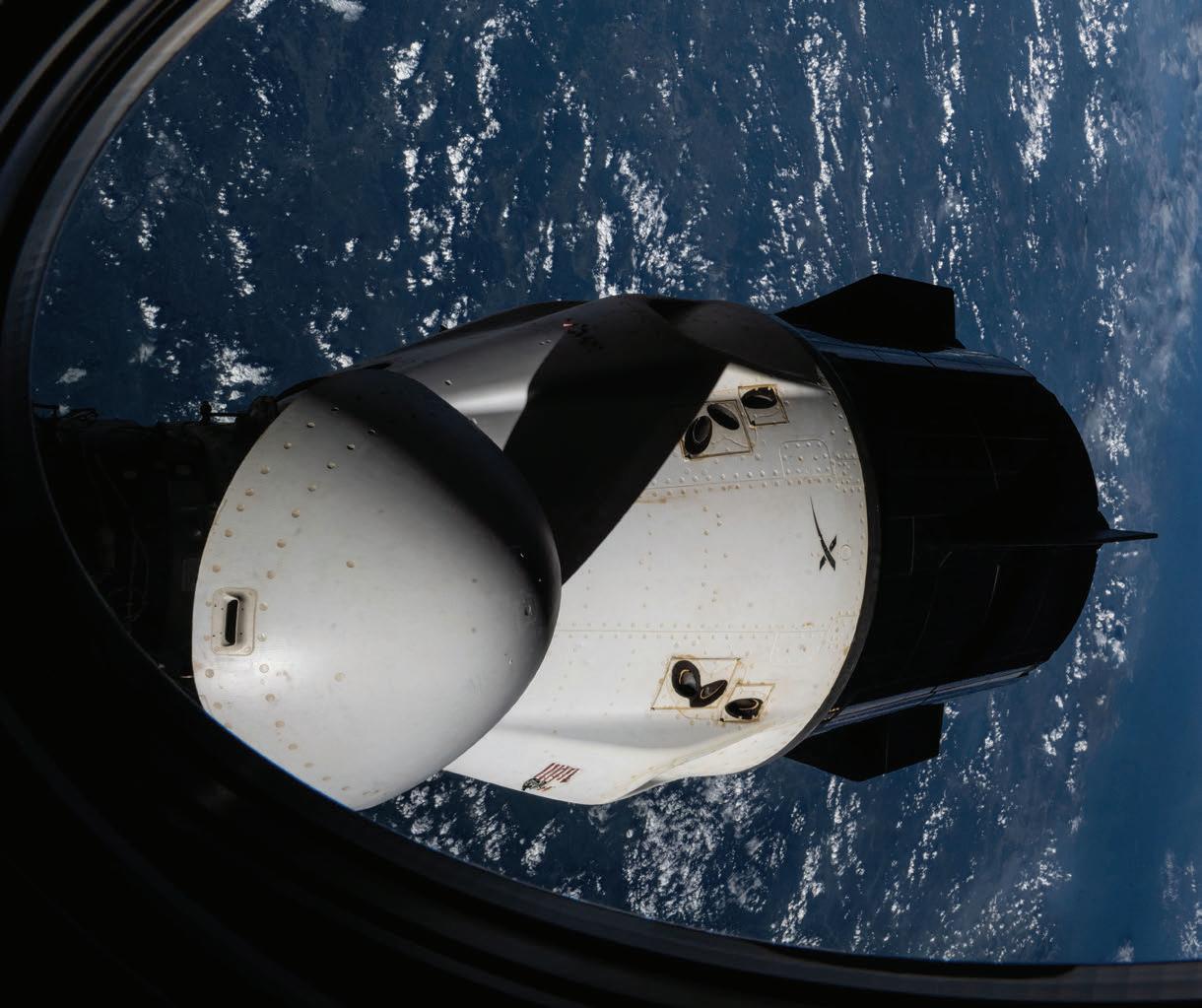

Robert Coffman, AE 04, is a cryogenics system engineer at NASA’s Kennedy Space Center.



Amanda Mitskevich, IE 97, was a program manager of the Launch Services Program at NASA’s Kennedy Space Center, where she oversaw the agency’s provision and management of domestic commercial launch services for robotic missions.


Ben Stahl, MS AE 07, previously worked in NASA’s Mission Control and with commercial crew partnering. Today, he works at SpaceX as a mission manager for the Dragon spacecraft.

Sarah Walker, AE 09, MS AE 11, is the director of Dragon’s mission management team at SpaceX. She joined SpaceX 10 months before the first Dragon journey to the ISS and has worked on every launch since.




Gabriel Morocoima, AE 10, was an ISS flight controller for Attitude Determination and Control Officer during NASA’s SpaceX Crew-1 mission in 2020. He is now the Guidance Navigation and Control Lunar Destinations Group lead for Gateway and EHP (EVA and Human Surface Mobility Program).

JENNIFER HERSEIM
For three decades, NASA launched American astronauts into orbit aboard its own spacecraft through the Space Shuttle Program. But when the program ended in 2011, the agency needed a safe, cost-effective alternative. Enter the Commercial Crew Program (CCP), where NASA sought out private companies like SpaceX and Boeing to develop spacecra capable of ferrying astronauts to the International Space Station (ISS).
“It was a bit of a cultural shift because we were helping shape industry to t our needs while working to develop non-NASA markets for commercial space,” remembers Dana Hutcherson, ME 00, deputy program manager for CCP. She joined NASA in 2006, working on the last Space Shuttle mission, before joining the new program. “NASA had proven the capability to go to low-Earth orbit with the Shuttle program. e idea was to seed these private companies to be able to do the same thing, so NASA could focus on the Moon, Mars, and beyond.”

Nearly 10 years later in 2020, American astronauts once again launched to space from American soil. is time on board a SpaceX Dragon spacecra , propelled by a Falcon 9 rocket. Yellow Jackets were there (on both the NASA and SpaceX teams) to usher in the new era of commercial spaceflight. Robyn Gatens, ChE 85, was acting director of the ISS during the historic mission. She’s now the ISS director and acting director of the Commercial Spaceflight Division within the Space Operations Mission Directorate at NASA.
Gabriel Morocoima, AE 10, was there during the rst launch preparing to maneuver the Dragon spacecra to safely dock once it reached the ISS.


Relying on private companies for routine ISS trips frees up NASA to pursue its deep space exploration goals and helps industry evolve in new ways, Hutcherson says. “As an agency, we want these companies to be successful in low-Earth orbit, which isn’t easy,” she says. “ ey still rely on us to help drive innovation, support crticial safety upgrades, and be an anchor tenant for their services while this new frontier expands,” she says.
For Hutcherson, who grew up in Augusta and Evans, Georgia, dreaming of working at NASA and traveling to space, this is all a dream come true. In her role, she assists in the overall business, program operations, technical management, and integration of commercial systems from the Kennedy Space Center.
She also created NASA’s Unsung Hero award to recognize the behind-the-scenes teams who make missions possible. Giving out the award is one of her favorite times of the year. “If you stop and think about it, every human who has le the planet from American soil in the last ve years was because of Commercial Crew and our collaboration with industry. It takes a talented team to pull that off,” she says.
Hutcherson’s other favorite time is the handover period, when one crew launches and another returns. “We executed 16 missions with industry in just six short years, 13 of them crewed,” she says. “I do love celebrating when we bring the astronauts home safely and our mission is complete.”



TECH
BY TONY REHAGEN
For generations of scientists, engineers, and other NASA personnel, including many who were not yet alive in 1969, the Apollo Moon landing was a watershed moment—the first steppingstone of space exploration. So in 2017, when the agency announced that a er 45 years the Artemis program would nally return humans to the lunar surface, many people working at NASA were elated.
“We were nally doing what everyone wanted to do,” says Liliana Villarreal, AE 96, MS AE 97, who had helped process payloads for shuttle delivery to the International Space Station before being tapped as director of the Artemis II landing and recovery at NASA’s Kennedy Space Center. “Our team has always been thinking of going farther.
at’s our driving ambition, our human instinct for exploration.”
In many ways, this trip to the Moon will be di erent, Villarreal explains. Artemis is about going to the Moon to stay, to set up human settlements, and learn what it takes to survive and thrive in extraplanetary conditions. Launched in 2022,
Artemis I was an uncrewed test flight of NASA’s Space Launch System (SLS) rocket and Orion spacecra . (Among the ight directors preparing for this mission was fellow Tech grad Heidi Brewer, AE 05.) Artemis II will use the SLS to carry four astronauts around the Moon to test the equipment and crew in deep-space exploration, and Villarreal oversees the recovery of the crew and Orion capsule upon their return to Earth a er their mission around the Moon. Artemis III will return humans to the lunar surface for the rst time since 1972.
Of course, for people to survive on the Moon, they’ll need an independent source of water—essential for human life by itself and as a potential source of breathable oxygen, not to mention as a fuel and propellant. Here too, Tech alumnae were integral in sending ahead equipment to find and drill for water beneath the lunar surface. Jackie Williams Quinn, CE 89, and Janine E. Captain, PhD Chem 05, led NASA’s PRIME-1 team, which landed a combination space drill and spectrometer on the Moon in March 2025. e lander ended up on its side, so the drill wan’t able to operate, but




As a Loads and Dynamics engineer for Barrios Technology, Kenneth Smith, MS AE 18, worked on the development of the new Gateway Space Station. Now he’s continuing that mission to return humans to the Moon as deputy launch director at Blue Origin.




Jean-Pierre de la Croix, CS 10, EE 10, MS ECE 12, PhD ECE 15, leads NASA’s CADRE project, which will, for the first time, demonstrate multi-agent autonomous exploration of the lunar surface. de la Croix is a robotics systems engineer in the Maritime and Multi-Agent Autonomy group at JPL. The CADRE technology demonstration involves three small lunar rovers that will work together autonomously as a team.

Russell Ralston, ME 12, AE 14, serves as evecutive vice president of EVA for Axiom Space. He leads the program designing new spacesuits that will be used for NASA’s return to the Moon. Ralston worked at Johnson Space Center as a co-op student while at Georgia Tech. He later worked at NASA developing spacesuit technologies.

the spectrometer was still able to gather crucial data, which was computer-modeled with help from Georgia Tech’s Regent’s Professor Thomas Orlando. “It operated awlessly,” says Quinn. “ e landing environment was more rugged than we had thought, but we showed that we could take commercial equipment and modify it to enable long-term habitation on a celestial body.”
e wide range of roles that Georgia Tech graduates have in getting humanity back to the Moon underscores the team e ort involved in undertaking such an endeavor. In fact, there’s a Yellow Jacket in NASA’s administrative offices helping oversee the entire project. “You’re not going anywhere without the people on the ground,” says Casey Swails, Mgt 07, NASA’s Deputy Associate Administrator. “Everyone sees the rockets and the landers, but they don’t see the people who make these missions happen. We rely on universities like Georgia Tech that are forward-leading, with students pushing boundaries and thinking about things di erently. It doesn’t matter your major—I switched out of engineering. ere is space in space for everyone.”



Luke Roberson, Chem 99, MS Chem 02, PhD Chem 05, and Daniel Yeh, PhD EnvE 00, are creating the next generation of water recycling and resource recovery systems to support missions to the Moon and to Mars. Roberson is a portfolio lead for Bioregenerative Life Support Systems within the Mars Campaign Office at NASA’s Kennedy Space Center, and Yeh is a professor at the University of South Florida.

NOV. 16, 2022
Artemis I
The uncrewed lunar flight test of the Space Launch System (SLS) sent the Orion spacecraft 1.4 million miles beyond the Moon and back to Earth on Dec. 11, 2022.

APRIL 2026
Artemis II
Four astronauts will perform a test flight aboard the SLS and Orion spacecraft. The crew will spend 10 days flying around the Moon.

MID2027
Artemis III
Four astronauts will travel to lunar orbit, where two astronauts will descend and spend a week near the South Pole of the Moon.
2027+
Artemis IV Astronauts will live and work in Gateway, the first lunar space station, which will prepare humans for missions to Mars.


MARS 2020 PERSEVERANCE
Here’s a sample of the more than two dozen Yellow Jackets who were behind the successful Mars 2020 Perseverance rover mission.


Jessica Clark, AE 10, MS AE 12, was a fault protection systems engineer at NASA’s JPL, who worked on both the Mars Perseverance rover and the Curiosity rover.



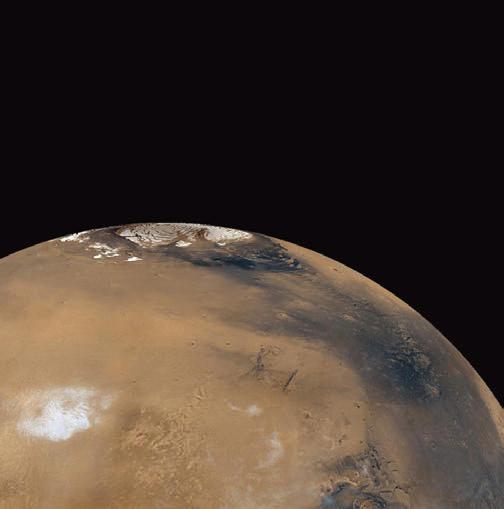




Alyssa Deardorff, AE 18, was a systems engineer on the Flight and Mission Systems teams for the Perseverance rover.


Mike Pauken, MS ME 90, PhD ME 94, served as thermal systems engineer on Mars 2020.



Emily Bohannon, ME 19, is a systems engineer, who worked on the mission operations and systems testbeds for Mars 2020.




Jason Ginn, AE 13, MS AE 14, was aeroshell cognizant engineer on the Mars 2020 mission.
Shivaly Reddy, MS ECE 06, worked on motor control flight software on the Mars 2020 mission, which included the rover and the descent stage.


Kareem Badaruddin, EE 86, MS EE 87, was supervisor for System Testbeds, Spacecraft Operability on the Mars 2020 mission.

Ian Clark, AE 03, MS AE 06, PhD AE 09, was a project systems engineer for Sample Cleanliness, Office of the Chief Engineer on Perseverance, and is now the Mars Ascent Phase lead for the Sample Retrieval Lander.




Growing up in the 1980s with dreams of one day becoming an astronaut, James Wray always thought it was a shame that he was born too late to become the first person to walk on Mars, an achievement that, back then, seemed imminent. Forty years later, Wray regrets that he’s now probably too old to accomplish that still-unful lled goal.
But as a professor in the School of Earth and Atmospheric Sciences at Georgia Tech, Wray is one of the many Yellow Jackets doing their part to set the trajectory and clear the landing ground for humanity’s overdue visit to one of its closest neighbors. “Exploration is at the core of our species,” says Wray. “Mars is the most sensible place to start that expansion. It’s the most Earth-like planet, and it’s one of the closest. It’s also a great place to test whether life is emergent in all planets, or if Earth is unique in that way. If there has never been life on Mars, I personally become a little more pessimistic of nding it anywhere.”
Wray and a team of NASA researchers found a potentially groundbreaking clue to that mystery when they were studying images of the planet’s surface and noted several dark streaks that appeared on the slopes of craters during warm periods that disappearred when the temperature dropped. Using the Compact Reconnaissance Imaging Spectrometer for Mars (CRISM) on the Mars Reconnaissance Orbiter, the team was able to analyze these lines and detect the presence of hydrated salts—the kind that precipitate from liquid water. Planetary scientist and Tech grad Lujendra Ojha, PhD EAS 16, was the lead author of the 2015 report. “Liquid water is a key requirement for life on Earth,” Ojha told Space.com at the time. “The presence of liquid water on Mars’ present-day surface therefore points to environments that are more habitable than previously thought.”
More recently, in 2025, Wray was part of another Tech group that discovered Jezero Mons, what they believe to be a composite volcano, including volcanic rocks that might provide more hints about the Red

TONY REHAGEN




Planet’s geological history and whether past hydrothermal activity might have provided a hospitable setting for microbial life. Wray and his fellow scientists might get to analyze these rocks rsthand because they are being collected by NASA’s Perseverance rover— and for that, they can thank fellow Yellow Jackets.
Philip Twu, PhD ECE 12, worked as a robotics system engineer on Perseverance. As supervisor of the Robot Operations and V&V Group at NASA’s Jet Propulsion Lab, he oversees the team that handles mission operations for every NASA robot currently on the surface of Mars. One of Twu’s biggest contributions was being system engineer for the rover’s autonomous navigation system, including hardware, so ware, and algorithms that enable Perseverance to cover more ground and perform more science in its mission to gather priceless samples from the planet’s surface for an eventual Mars Sample Return mission to Earth. Currently, Twu and his colleagues at JPL are guring out exactly how the rover will transfer those rock and regolith samples to the Mars Ascent Vehicle, which will then launch a container of samples into Mars orbit to be captured by an Earth Return Orbiter for their trip home, all robotically. “We’ve never brought anything back from the surface of another planet,” says Twu. “It will be challenging. But I want to answer the big questions in life. Where do we come from? Where are we going? We’re a step closer to nding out.”
BY JENNIFER HERSEIM
Iof


glow from planets around other stars or faraway galaxies whose light has been stretched by the expanding universe,” Ballantyne says.

n just three years, the James Webb Space Telescope (JWST) has transformed astronomy. It’s provided evidence that the universe might be expanding more slowly than previously thought, revealed Earth-like extrasolar planets, and captured the distant light of the earliest galaxies.
“One of the most fascinating questions that it might help answer is, can we detect life on other planets?” says David Ballantyne, a physics professor at Tech who studies supermassive black holes.
“JWST is hard to compare to Hubble or other previous telescopes because it’s so sensitive to very distant and dim sources. It’s optimized to detect infrared light, which allows us to detect the warm

Several Yellow Jackets helped prepare JWST for launch. Robby Estep, AE 97, was the instrument manager for the Micro-Shutter Subsystem. ese small windows with shutters about the size of a few human hairs, were developed for JWST’s Near Infrared Spectrograph.
Len Seals, MS EE 99, MS Phys 00, PhD Phys 01, the associate branch head of the Optics Branch at NASA’s Goddard Space Flight Center, worked on the telescope’s Integrated Science Instrument Module. He supported optical analysis that allowed for the optimal alignment of the instruments. Later, he worked as a straylight analyst, building straylight models for several of JWST’s instruments. When he joined the project, it was facing cancellation because of delays and budget overruns. On top of that, Hurricane Harvey ooded their test facility in Houston in 2017. “With the dedication of the project and NASA we were able to complete the integration of instruments largely on time,” he says.
Before the telescope could launch, Jesse Leitner, MS AE 92, PhD AE 95, was part of the final risk assessment. He and the chief engineer at Goddard described the challenges of testing JWST’s







Gregory Dubos, MS AE 07, PhD AE 11, is Europa Clipper flight director and Spacecraft Systems lead.
Tessa Rogers, MS AE 23, was a systems engineer at Northrop Grumman who worked on JWST. She’s now a mechanical engineer at Lockheed Martin.








Nathan P. Brown, AE 16, MS AE 18, PhD AE 21, was a co-op student who worked as a structural and thermal engineer on the James Webb and Space Launch System with ATA Engineering, Inc.


readiness in a 2022 article for Aerospace America, including deploying a tennis-court-sized sundshade under extreme conditions. In the end, they signed o that the telescope was ready for its launch in December 2021.

JWST’s early findings could provide clues to a number of astrophysics questions. “For the last 25 years, we’ve had a cosmological model dominated by dark matter and dark energy yet, we don’t know what those are,” says Ballantyne. “Recent data from JWST suggests that the universe is not expanding as quickly as we once thought. ere could be something deeper at play that we don’t really understand. Perhaps the universe isn’t destined to expand forever.”
Those questions interest Kate Napier, Phys 17, who is part of the Observing Specialist Team at the NSF-DOE Vera C. Rubin Observatory in Chile. e observatory features the largest digital camera (3.2 billion pixels) ever built. For the next 10 years, it will capture the entire Southern Hemisphere sky every three to four nights. “It’s essentially building a time lapse video of the night sky. e rst year of the survey is expected to surpass the total data gathered by all previous optical





observatories combined,” Napier says. “One of the main goals is to shed more light on the nature of dark matter and dark energy.”


For her postdoctoral research, Napier will use the Rubin data to study the current expansion rate of the universe. She’s using an independent measurement method that relies on quasars—the bright cores of some galaxies that are powered by supermassive black holes—whose light has been bent by galaxy clusters, which act like a cosmic telescope, magnifying objects farther away, Napier says.
Working at the observatory is personal to Napier, who advocated for it to be named a er Vera C. Rubin, an American astronomer who provided the rst compelling evidence of dark matter. It’s the first national observatory that the U.S. has named a er a woman.
“Georgia Tech gave me the opportunity to be mentored by a lot of women in science,” says Napier, who served as president of the Society of Women in Physics while at Tech. “My leadership skills ourished because of the opportunities I was part of at Georgia Tech.”










Ever wondered what a black hole looks like or how GPS knows exactly where you are? We asked Georgia Tech’s experts to explain some of the great mysteries of space. Yes, this is rocket science, but this time you don’t have to read a 1,000-page textbook for the answers.



















ASTRONAUTS GRADUATED FROM GEORGIA TECH. 14
Astronaut Shane Kimbrough, MS OR 98, visited Aerospace Engineering students in their labs March 4, 2022.
Yes, and we tested it. In the fall of 2022, NASA’s Double Asteroid Redirection Test (DART) spacecraft smashed into the asteroid Dimorphos, altering its orbit. While Dimorphos wasn’t a threat to Earth, the demonstration showed a planetary defense technology called kinetic deflection, which deflects an asteroid by a kinetic impact without an explosive device, could help avert a global catastrophe if such an event happens. How efficient the kinetic push is depends not only on the impactor’s collision but also on the fragments generated by the collision that depart from the asteroid at fast speeds, usually called “ejecta.” With the DART team, I studied the influence of ejecta on the push. We found that the ejecta formation plays a critical role in the efficiency of the push. We also proposed that smaller impactors, instead of a single big impactor, would enhance the push. This information could help NASA determine how to more strategically send an impactor/impactors for the greatest push possible.
—Masatoshi Hirabayashi, Associate Professor, Daniel Guggenheim School of Aerospace Engineering









Other than on Earth, where in the solar system are we most likely to find water, and do you think there is currently life there?
There is water all around the solar system: Asteroids, comets, and other icy objects abound and there is likely water in permanently shadowed craters on the lunar poles and on Mercury, too. Many of these places are too cold to be habitable, but some, such as Ceres, a dwarf planet in the asteroid belt, might have been habitable in the past.
Jupiter’s moon Europa has about twice as much water as Earth despite being only 1.5% of Earth’s size. Europa may be habitable, but there’s a lot we still don’t know. One of Saturn’s moons, Enceladus, is thousands of times smaller than Earth, and likely has a subsurface ocean. The spacecraft Cassini was able to image plumes of ice particles jetting into space from beneath its icy crust. Cassini also found organic (carbon-bearing) molecules in the plume, which could be produced with or without life; we need to visit to find out!
Mars is covered in water that’s frozen and buried under dust and rock at its poles and likely deep within its crust. At the surface, it’s too cold and dry for life as we know it, but certain near-surface spots might be habitable every once in a while. And the subsurface has temperature and pressure similar to places on Earth where we know life is abundant. I think there’s a







UNIVERSITIES IN NASA’S DEEP SPACE NETWORK, THE AGENCY’S INTERNATIONAL ARRAY OF GIANT RADIO
ANTENNAS SUPPORTING INTERPLANETARY SPACECRAFT MISSIONS.



good chance we’ll find life there, and if so, we might even discover that we are Martians—that life started on early Mars and was brought to Earth by large meteorite impacts. It sounds spectacular, and it might just be true.
Saturn’s moon Titan might have a subsurface ocean today. And don’t count out Pluto: It, too, might have a subsurface ocean!
We should think about more than just water: A recent study found that of all the different kinds of oceans that can form on exoplanets, water isn’t even the most common! For sun-like stars, ethane (a hydrocarbon, like gasoline) and sulfuric acid might be more common than water. We don’t really know the range of chemistry that can happen in non-water liquids like methane, ethane, and sulfuric acid. Future missions will explore this further, including NASA’s Dragonfly rotorcraft, which will head to Titan to explore its methane seas and rain, and Rocket Lab’s mission to Venus, which will include an instrument that explores the chemistry in Venus’ clouds of sulfuric acid.
—Christopher E. Carr, Assistant Professor, Daniel Guggenheim School of Aerospace Engineering and School of Earth and Atmospheric Sciences
INCREASE IN THE PROPELLANT CAPACITY IN SATELLITES FROM A NOVEL FLUID MANAGEMENT TECHNOLOGY THAT TECH RESEARCHERS DEVELOPED. 30%
Researchers from Georgia Tech tested multiple CubeSat experiments in microgravity this year.
1.35
MILLIMETERS, OR THE THICKNESS OF A DIME, IS THE LEVEL OF PRECISION THAT GEORGIA TECH’S PROPULSION SYSTEMS MUST BE ABLE TO ACHIEVE SO THAT TWO SPACECRAFT CAN SEND STARLIGHT TO EACH OTHER WHILE 100 METERS APART.





We live surrounded by unseen radio waves. Some are naturally occurring, like the light from our Sun, and others are created by human activities. The Global Positioning System (GPS) was built to use human-made radio waves that instantly locate your position anywhere on the Earth to within a few meters. A device as small as a quarter that fits in your cell phone or automobile receives these radio waves and decodes them into range measurements that are unique to your position. The signals are transmitted by GPS satellites in orbit that can be received by anyone with the proper equipment who can see them in the sky. The GPS signals contain enough information to determine the satellite’s position—where the signal came from—and the amount of time it took to reach your position. Since radio waves travel at the speed of light, this time of travel information is converted to a range measurement. We live in a three-dimensional universe, so we should need just three GPS measurements to determine our position. But we also have to correct the time on our GPS receiver to line up with GPS standard time, so this is another unknown, requiring a fourth GPS measurement. The GPS constellation is designed with enough satellites that you should always be able to make at least four measurements from any place on the Earth if you have a clear view of the sky.
—E. Glenn Lightsey, John W. Young Chair, Professor, Guggenheim School of Aerospace
Engineering




The short answer is no. The Outer Space Treaty (formally, the Treaty on Principles Governing the Activities of States in the Exploration and Use of Outer Space, including the Moon and Other Celestial Bodies) states that the Moon is not subject to national appropriation by claim of sovereignty, occupation, or other means, so no country can claim to “own” any territory on the Moon. That said, the United States made it clear in the 2015 Commercial Space Launch Competitiveness Act that under U.S. interpretation, this limitation still allows for U.S. citizens and companies to recover, utilize, and sell lunar resources. (A common analogy is to fishing in international waters—you can’t claim to own the ocean, but you can catch and sell fish you catch in international waters.) So, while no one can claim territorial rights on the Moon, they may still develop and use lunar resources. The details of how this would work in practice are yet to be determined.
— Mariel Borowitz, Associate Professor, Sam Nunn School of International Affairs










TECH PROFESSOR MASATOSHI HIRABAYASHI IS ONE OF EIGHT SCIENTISTS SELECTED TO STUDY ANCIENT ASTEROIDS AS PART OF NASA’S LUCY MISSION. LUCY WILL EXPLORE A RECORD NUMBER OF ASTEROIDS. NASA/ISAAC WATSON

TIME THAT GEORGIA TECH’S LATEST CUBESAT, CALLED ORCA2B, SUCCESSFULLY DEPLOYED FROM A SPACEX FALCON 9 ROCKET THIS APRIL. ORCA2B WILL HELP RESEARCHERS BETTER TRACK OBJECTS IN EARTH’S ORBIT. IT’S THE FIRST OF TWO CUBESATS AS PART OF THE ORBITAL CALIBRATION 2 MISSION. RESEARCHERS FROM TECH’S SPACE SYSTEMS DESIGN LAB HAVE BEEN WORKING ON THE CUBESAT SINCE 2021.
at the moment of deployment







If you happened to be in the vicinity of a lonely black hole, floating somewhere in our galaxy, you probably wouldn’t know it was there. If you were close enough, you would start falling toward it, but even in that close approach it wouldn’t look like much of anything. You would feel it but not be able to see it. Now, if our black hole was pulling in some gas from its surroundings, perhaps from a companion star or a gas cloud, the surrounding area would glow as this gas swirls, heats up, and emits light. You would certainly feel warm during your journey, and you still wouldn’t see the black hole itself, but you’d be treated to a light show. It’s only when you focus on the center of this glow (and at the right frequency of light!) that you would make out the black hole’s telltale “shadow.” The absence of light against the surrounding brightness is the quintessential image of a black hole and it is one we have finally captured with our telescopes.



When two satellites are heading for collision, which one must move out of the way?



—Feryal Özel, Professor and Chair of the School of Physics


Neither! There is currently no globally agreed-upon requirement that states when or how a satellite should maneuver to avoid a collision. Today, individual spacecraft operators determine whether they want to maneuver, and coordination between spacecraft operators—if it occurs—is often conducted by phone or email, although sometimes contact information isn’t readily available. This lack of coordination for space traffic has become a more urgent issue as the number of satellites has skyrocketed in recent years. Many countries, including the United States, are investing in improved space situational awareness —the ability to track spacecraft, predict their future location, and identify potential collisions. Some industry groups have suggested potential “right-of-way” rules that could be applied for satellites, but these have not yet gained broad acceptance. The United Nations Committee on the Peaceful Uses of Outer Space recently formed an expert group on space situational awareness to discuss these issues, so we may see advancements in this area soon.
—









Mariel Borowitz, Associate Professor, Sam Nunn School of International Affairs


80% $300,000 18
OF UNDERGRADUATE AE STUDENTS ENGAGE IN RESEARCH BEFORE THEY GRADUATE.
VALUE OF THE GRANT THAT KICKSTARTED THE DANIEL GUGGENHEIM SCHOOL OF AERONAUTICS IN 1930, WITH $6,000 A YEAR DEDICATED TO RESEARCH.

PHOTOVOLTAIC CELLS WILL HITCH A RIDE ON THE INTERNATIONAL SPACE STATION FOR TECH RESEARCHERS TO STUDY THEIR LONG TERM OPERATION IN SPACE.














When do you think humans will be living on Mars?
My best guess is that it may take a few decades before humans are living continuously on Mars, but this depends upon many factors, such as maintaining our national commitment to exploration; international competition or cooperation; how much the private sector, AI, and robotics accelerate space exploration; avoiding a major war; and more fundamentally, whether Mars’ gravity is enough to allow humans to fully adapt, and ultimately go through our entire life cycle. The Moon is key to addressing that fundamental question. If other small mammals and, ultimately, humans can adapt to and sustain themselves on the Moon, then Mars is almost surely feasible, despite many technical challenges. Before that happens, there will be lots to celebrate: the first human landing, the first pizza made on Mars, the first generations of animals, and much more. We
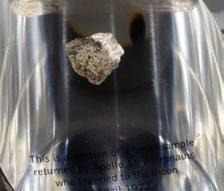
A lunar sample collected by John Young, AE 52, HON PhD 03, during Apollo 16 is on display in the Grove level of the Price Gilbert Memorial Library. It’s estimated the sample was on the Moon for at least 400 million years. Young gathered it at the base of “Stone Mountain,” the codename Young gave to what NASA calls the Descartes site.


will still have a need to connect to the natural world. I recently met Japanese Astronaut Takao Doi, who is already growing trees under low pressure near Kyoto, Japan, in anticipation. Imagine a future where you are on Mars, sitting in a rich and vibrant garden. What plants would you have around you? We will bring all the good and the bad parts of ourselves and will see how they interact with a capital-intensive lifestyle that will require incredible levels of coordination. That might be one of our biggest challenges, but also an opportunity for us to come together, whether the goal is to live on Mars or to address planetary-scale challenges on spaceship Earth.

—Christopher E. Carr, Assistant Professor, Daniel Guggenheim School of Aerospace Engineering and School of Earth and Atmospheric Sciences
Beyond housing one of the largest science-fiction collections in the world, the Georgia Tech Library is also home to several priceless artifacts of space and astronomy history.


John Flamsteed (1646–1719) was the first Astronomer Royal of England and a perfectionist who hesitated to publish his work. The Georgia Tech Library’s rare books collection includes a second-edition French copy of The Atlas Céleste de Flamstéed, printed in 1776, a rare catalog published after Flamsteed’s death that features 2,935 stars. Astronomers used his celestial atlas for nearly 100 years. It includes an illustration of the first printed Moon map engraved by Giovanni Domenico Cassini in 1679.
De le Stelle Fisse is considered the first printed star atlas of the Western world. This rare book, housed in the Georgia Tech Library, was written by Alessandro Piccolomini in Venice circa 1566. The book includes 47 star maps and three pages concerned with the rising and setting stars in the 12 zodiac signs.






We’re on the verge of a new era of aviation that promises faster, quieter, and more sustainable aircraft than ever before. Of course, Yellow Jackets are key players behind many of the innovative designs that are revolutionizing the industry.
BY GEORGE SPENCER

Michael Buonanno, MS AE 02, PhD AE 05, is leading development of the X-59 “Quesst,” a supersonic jet that delivers a quieter sonic boom.









Goodbye, tube-and-wing jets. Hello, blended-wing-body (BWB) aircra . JetZero imagines a future in which traditional airliners made by Boeing and Airbus are replaced by ones like its radically reshaped Z4. is 200- to 250-passenger jet will have the wingspan of a B-52, y 5,000 nautical miles at up to 45,000 feet, and t into existing airport gates. Dedicated bin space, digital viewscreens, and seats with forward views will add pizzazz. Bethany Davis, MBA 11, MS AE 11, heads the Z4 program.







The most attractive aspect of this all-wing plane is its fuel efficiency. Thanks to a more aerodynamically shaped and lighter airframe than existing commercial jets, the Z4 will use 50 percent less fuel.



















It will also be quieter for people on the ground—and in the plane—because its two engines are pod-mounted on top of the aircraft.












The U.S. Air Force has invested $235 million in the project. Delta, Alaska Airlines, and United have announced partnerships with JetZero, and United has already placed a “conditional” order for up to 200 of the planes, which will be manufactured at a $3.7 billion new factory in Greensboro, North Carolina.



“De-risking” is a key part of the Long Beach, California, company’s strategy. “We’re not trying to reinvent everything. The Z4 uses very standard electrical and hydraulic systems. They’re just organized into a different shape,” says Bethany Davis, MBA 11, MS AE 11, who heads the Z4 program and its FAA certification process.

A full-size experimental prototype of the plane will fly in 2027, and Davis believes the FAA will green-light the Z4’s airworthiness in time for the eye-popping plane to serve passengers in the early 2030s.



“JetZero will be the first to bring the blended wing to market,” says Davis, who previously served as director of Flight Innovation at Gulfstream Aerospace under president Bryan Moss, IM 62. “As Tesla did with electric cars, everybody else will follow suit. We believe that by 2050 all commercial airplanes will be this shape.”




e X-59 is nosy but not intrusive. Its nickname Quesst (Quiet SuperSonic Technology) gives away the needle-nose jet’s purpose. Starting this year, the experimental cra will y over U.S. cities at up to 925 m.p.h., about 1.4 times the speed of sound, without jarring people on the ground.
Supersonic nonmilitary ights over the U.S. have been banned for more than 50 years. e hope is that a less noticeable X-59 will open the door to relaxed regulations and commercial supersonic ights in jets modeled a er the X-59.

While the X-59 borrows parts from other aircraft, such as landing gear from an F-16, it sports a novel innovation unrelated to its sound-dampening goal. Due to the plane’s sleek streamlining, the cockpit sits so low in the fuselage it has no forward-facing window. Pilots will see ahead thanks to an eXternal Vision System that will transmit images from cameras to a cockpit monitor.


The plane’s pointy proboscis, highly swept wings, canards (small wings in front of the cockpit), and all of its exterior features have been designed to tailor the way air flows around the aircraft. The 35-foot-long needle nose is slightly more than one-third the plane’s 99-foot length, but since it’s made of ultra-light carbon fiber composites, it weighs only 300 pounds.


Instead of a sharp, sudden rifle-shot boom, the jet, according to computer simulations, will sound more like the muffled thump of a closing car door. NASA researchers on the ground will study people’s reactions.
“The number one requirement of the X-59 is that it have an acoustic characteristic that can be scaled up to a much larger product,” says Michael Buonanno MS AE 02, PhD AE 05, an aerospace engineer with Lockheed Martin. His company’s secretive Skunk Works advanced technology division has been crafting the X-59 in association with NASA since 2016.

“The shock waves are still shock waves, but they all stay carefully distinct and don’t merge into one very large shock wave,” says Buonanno. “Because they don’t coalesce, you get this thump rather than the loud boom.”


So Nick Borer, MS AE 01, PhD AE 06, and his team at NASA’s Langley Research Center and Armstrong Flight Research Center came up with a startling strategy. Two large propellers at the wingtips would power the craft while cruising, but 12 wing-mounted propellers driven by electric motors would create more lift on takeoff and landing. In flight they would retract to smooth air flow over the wings.
“Even though we increased weight by adding 12 motors only used for takeoff and landings, the amount of drag we saved in cruising was so substantial, it was better than adding that amount of weight in batteries,” Borer says.



Some aircra seed clouds to make rain. e X-57 Maxwell never ew, but it seeded ideas for the U.S. aviation industry with its innovative distributed propulsion technology. NASA wanted the four-seat aircra to popularize short-hop ights by solving aerodynamic and propulsion problems that bedeviled electric aircra developers. e problem is today’s batteries simply don’t have enough oomph to compensate for their weight in traditional aircra designs.

Mechanical issues with the motors forced NASA to ground the project before any test flights. Nonetheless, the Maxwell sparked change in the aviation industry.




Joby Aviation, now a major player in the vertical takeoffand-landing electric air taxi industry, got a boost when it won the contract to help design the plane. EP Systems, a leading U.S. aviation battery supplier, benefitted from its involvement as well. The X-57’s concept lives on in the Electra, an eight-engine electric plane that looks much like the Maxwell.
The more than 100 papers generated by Borer’s team have been a boon, too. “The neat thing about not chasing a profit at NASA is that we published all the warts along the way—all the stuff that broke and didn’t work,” recalls Borer.
The X-57’s academic reference platform still gets many requests. Tech professors Dmitri Mavis and Brian German in the School of Aerospace Engineering and Cedric Yves Justin and Evan Harrison with Tech’s Aerospace Systems Design Laboratory have all used findings from X-57’s saga in their research.




Hermeus is all about speed, in business and in ight. e Atlanta-based startup is racing to build the fastest aircra in the world, jets capable of ying ve times the speed of sound. Founded in 2018, the company has grown to more than 200 employees and soared past milestones that typically take aerospace companies years to reach.
eir secret? A startup mentality and iterative design process, says AJ Piplica, AE 10, MS AE 12, cofounder and CEO. Hermeus isn’t trying to do “everything all at once,” he explains. Rather than investing years into a single aircra that might fail during testing, Hermeus rolls out products quickly and more frequently, getting them into the air to solve complex development issues sooner. Two prime examples are Chimera, a hybrid turbojet-ramjet engine that will power their hypersonic jets, and Quarterhorse, the company’s progressive hypersonic ight program.


Chimera will be flight-tested in the Quarterhorse Mk 3. The program includes four vehicles from Mk 0, which tested remote command and taxiing, to Mk 3, designed to demonstrate Chimera in flight and break the airspeed record held by SR-71. Hermeus built Mk 1 in less than a year and flight-tested it at Edwards Air Force Base earlier this year. Mk 2 is currently in development and is on track to fly later this year. “Flight data is hard to get for things that fly really fast, so it’s super important to get yourself up in the air and gather data as quickly as you can,” Piplica says.JENNIFER HERSEIM



Chimera modifies existing turbine engines, which allows Hermeus to tap into supply chains, reduce costs, and accelerate development.


Stochastic. at’s a word aerospace engineering professor Marilyn Smith, AE 82, MS AE 85, PhD AE 94, uses when explaining her research as the director of Tech’s Vertical Li Research Center for Excellence.
The term comes from the Greek word stókhos, which means guess. Smith does more than that. She applies interactional physics to solve outcomes of aircra behaviors in wildly complicated aviation environments.
“ ink of it as driving behind an 18-wheeler, and you get buffeted badly,” she says. “Now imagine you’re ying close to a building in the urban canopy, doing a shipboard landing, or near trees on a rescue mission. How do you make sure you control the aircra , y safely, protect your cargo, and mitigate wear-and-tear on the vehicle’s components?”
To find answers, she and her seven-university team of experts uses high-performance computing to perform Large Eddy Simulations. This mathematical model for replicating turbulence requires

weeks and millions of computer hours of analysis.
Such studies of unsteady aerodynamics and computational aeroelasticity are backed by more than $200 million in funding from NASA, the NSF, and the Army and Navy. Smith and researchers from the University of Michigan and Washington University (St. Louis) and elsewhere study all manner of aircra —rotary-wing, xed wing, and rocket-powered launch vehicles.
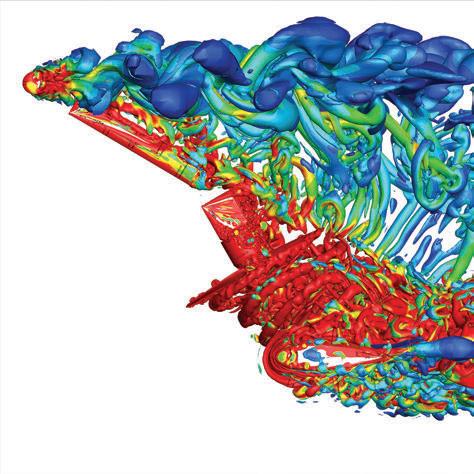
“We call what we study aeromechanics because it includes aerodynamics, structural dynamics, acoustics, and handling qualities. You can’t just do one. You have to do all of it,” she says.
Rotorcra hybrids of helicopters and planes play a prominent role in her research. Some of their concepts date to the 1940s. ey never ew because lightweight composite materials, supercomputing power, and electric propulsion didn’t exist then.
“I’ve worked on everything through my career from fighters and military transports to launch vehicles, rotorcraft, and various things I can’t talk about,” says Smith, who admires the multifunctionality of rotorcra . “ eir military component helps save soldiers’ lives,” she says. “We saw their many life-saving capabilities beyond that in the Texas oods, where Blackhawk helicopters rescued people in trees.”
After nearly 50 years at Tech, Smith will retire in 2026. Like many AE students in the 1970s, she wanted to work for NASA. Her hero was Scotty, the engineer on Star Trek. “But when I got into aviation, it completely changed what I wanted to do.”
A model from one of the recent studies that VLRCOE conducted shows how air flows around a tiltrotor in a wind tunnel when it’s converted from a rotor to a propeller. The group’s work provides new insights into complex proprotor-wing aerodynamic interactions.


























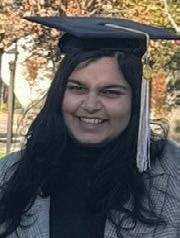












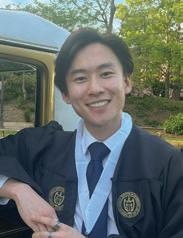



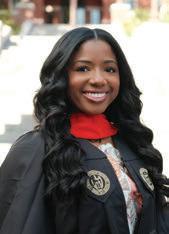



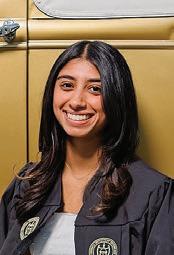







More than 11,000 students have graduated from Georgia Tech since last fall. Meet a few of the newest members to join the Yellow Jacket alumni family.
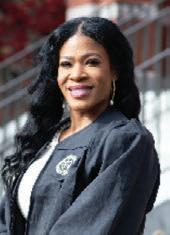





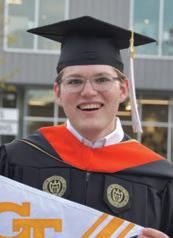


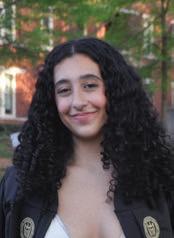



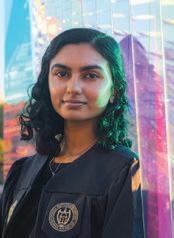









BY SHARITA HANLEY
THESE RECENT GRADUATES are using real-world experience to research and solve complex challenges in the space and aviation industries.
Graduating from Georgia Tech is a remarkable achieve-

If you could visit any celestial body, where would you go and why?
“Venus. Despite being Earth’s ‘sister planet,’ the atmosphere of Venus presents clouds of sulfuric gas and deadly heat. I’d like to further understand how technologies can be developed to withstand these conditions and perhaps even allow humans to set foot there one day.”
“Whether people realize it or not, space touches every part of our lives,” Ishani Peddi, Econ 25, says. That’s one of the reasons why she minored in aerospace engineering. “It gave me the opportunity to make a meaningful impact on various sectors and communities.”
As a 2023 Brooke Owens Fellow, Peddi worked as a Strategic Operations Intern at Ball Aerospace (now BAE Systems) in Washington, D.C., where she tackled real-world space sustainability challenges, crafted strategy for wildfire detection satellites, and briefed leadership using materials she prepared for Congressional hearings.
In 2024, as a Federal Jackets Fellow, Peddi joined NOAA’s Office of Space Commerce and led deliverables on international coordination for space traffic management. This summer, she interned at the Center for Strategic and International Studies with the Aerospace Security Project, where she investigated China’s commercial space manufacturing capabilities, crafted insightful speaker questions, and attended space investment summits—all while contributing to international policy research as a Matthew Isakowitz Commercial Space Scholar. In the fall, Peddi is returning to Tech as a graduate student to pursue a master’s in International Affairs, Science, and Technology.
ment, and these Yellow Jackets have taken their talents to new heights. rough their journeys at Tech, they’ve gained a foundation for a career in the space and aviation industries, tackled problems, and pushed the boundaries of innovation.
“I became interested in aerospace engineering in my high school physics class after we learned about orbital mechanics,” Calvin Tomsic, AE 25, says. “At Tech, I became fascinated with aircraft and fluid mechanics. Fluid mechanics is everywhere in daily life, and yet there is still a lot to discover.”

Tomsic deepened his passion through Tech’s combined Aerospace BS/MS honors program, where he explored the complexities of fluid mechanics—a field he found both omnipresent and full of unanswered questions.
If you could visit any celestial body, where would you go?
“I’d visit Europa. Having humans on the ground to collect data and samples would be invaluable. Seeing Jupiter in the sky from its moon would be surreal.”
During his time at Georgia Tech, Tomsic’s most impactful experience came through the Department of Defense’s SMART Scholarship program. There, he worked directly with warfighters to improve the defense systems they depend on, blending technical expertise with mission-critical applications.
The BS/MS program also gave Tomsic the opportunity to collaborate closely with a faculty advisor as an undergraduate, a mentorship that shaped his academic and professional trajectory. “A graduate degree has become an implicit requirement for many upper-tier aerospace engineering jobs, so once I identified that this program aligned with my career goals, I knew that having the right faculty advisor would enhance my experience.”
BY SHARITA HANLEY
GLOBAL REPRESENTATION
61 U.S. states and territories
TOP FIELDS OF STUDY
Bachelor’s
MORE THAN 11,000 YELLOW JACKETS —11,109, to be exact— earned degrees from the Institute in Fall 2024 and Spring 2025. ese Ramblin’ Wrecks, who hail from 61 U.S. states and territories, and 99 countries across the globe, join Tech’s growing alumni network. is group of graduates represents academic achievement, ambition, adaptability, and global reach. And they’re eager to contribute and rede ne what’s possible on the world stage. No wonder e Princeton Review named Georgia Tech the fourth Best Alumni Network among public colleges. graduates have multiple Tech degrees
Master’s
Doctorate
99 countries* AND 1,352
DEGREES EARNED* *Based on last known addresses
6,2514,57440846 (56.3%) graduated with a master’s degree (41.2%) graduated with a bachelor’s degree (3.6%) graduated with a doctorate (0.4%) obtained a Georgia Tech certificate
MULTIPLE DEGREES EARNED
1,365 (12%)
1 individual has 5 degrees
5 individuals have 4 degrees
80 individuals have 3 degrees
1,279 individuals have 2 degrees
*Some individuals earned multiple degrees and others graduated from dual-degree completion programs.

OVER THE COURSE of three packed days, President Ángel Cabrera, MS Psy 93, PhD Psy 95, embarked on a journey that took him to seven towns, involved 13 events, and spanned 775 miles for the 2025 President’s Summer Tour.
For the rst time in the tour’s history the journey began in Florida, a nod to the Institute’s expanding in uence, with stops in Ponte Vedra and Jacksonville. From there, Cabrera traveled

CABRERA TOURED SEVEN CITIES THIS SUMMER, HIGHLIGHTING
BY SHARITA HANLEY
up the Georgia coast to Savannah, where he met an alumni couple who launched the state’s rst oating oyster farm and helped them harvest oysters.
Next, Cabrera toured the Hyundai Motor Group’s Metaplant America in Ellabell. Traveling down the road to Burke County, he visited Georgia Power’s Vogtle Electric Generating Plant in Waynesboro, and engaged in conversations about the future of clean
energy. In Augusta, the spotlight shifted to advanced manufacturing as the president visited Textron Specialized Vehicles, a global leader in recreational and utility vehicles. Lastly, in Covington, Cabrera suited up for a cleanroom visit to Absolics Inc., where alumni are helping produce the world’s rst glass substrate for advanced semiconductor packaging.
At every stop, Cabrera met with incoming students, alumni, business leaders, and local officials, proving that the Institute is an economic force and a community resource deeply and positively impacting the region.
HAPPENED TO THE STAINED GLASS WINDOW IN THE OLD STUDENT CENTER AFTER THE RECENT RENOVATIONS?” Becca Volk, AE 21, MS AE 24
The central panes of the Spirit of Tech stained glass window were relocated after the renovations to the Institute’s library archives, where they remain in storage today. The archives protect and preserve Tech history for future generations of Yellow Jackets. The window was designed in 1985 by award-winning stained glass artist Seranda Vespermann and fabricated by her son, Christopher Vespermann.

“When I was involved in Student Government, I spent countless afternoons and late nights in the SGA office, just inside the entrance near the piece. The stained glass window became a kind of landmark for me and a visual fixture of my time in school.”
Zoë Sieling, AE 20, shares a memory of the stained glass window that was located in the former Student Center. The piece inspired her to create her own version for her home.




The Spiritof Tech window was visible from the food court in the old student center.
Submit your question or share a memory at GTalumni.org/Wrecksplain


Our campus continues to evolve in extraordinary ways, but one thing remains timeless: our commitment to develop leaders who advance technology and improve the human condition. This mission is at the heart of Georgia Tech’s continued success, and it is why we are routinely recognized as a national and global leader. It’s also one we cannot ful ll without your generous Roll Call support.
You may have seen some of our recent accolades:
• Georgia Tech was named the best value public college by The Princeton Review for the third consecutive year.
• Forbes recognized Georgia Tech among the top 10 “new Ivies” for a second year in a row.
• U.S. News & World Report ranked Georgia Tech among the top 10 public universities in the country for 2025.
• The National Science Foundation has ranked Georgia Tech’s research enterprise No. 1 in the U.S. among institutions without a medical school for four years in a row.
None of this would be possible without your support. That’s why I invite you to join me in contributing to the 79th Roll Call, which is now in full swing. Together, we can ensure that Georgia Tech’s legacy of excellence and opportunity endures for generations to come.
Your Roll Call gi is also a vital part of Transforming Tomorrow: The Campaign for Georgia Tech. By supporting our students, research, campus, and community, you’re building a foundation that ampli es our impact both locally and globally. Let’s come together, as Yellow Jackets always do, to take Georgia Tech to a greater level of excellence and impact than ever before. Your gi makes a di erence. Let’s Transform Tomorrow together.
Sincerely,

Ángel Cabrera President, Georgia Institute of Technology


Scan to give now!





















BY MARTIN LUDWIG Senior Director of Travel
TRAVEL WITH FRIENDS WHO KNOW THE GOOD WORD.
I get asked all the time about whether the Georgia Tech Alumni Travel program is open to everyone. The answer is yes! There are no membership fees, and everyone is welcome to join the journey. So go ahead and invite your family, friends, and travel buddies. The more, the merrier!
2

PACK AN EXTRA SET OF CLOTHES IN YOUR CARRYON.
Lost luggage happens, and it’s never fun to land in a new country without your essentials. Pack an additional outfit, extra medication, and copies of your travel documents in your carry-on. It’s a small move that can save you a big headache.
3

IMAGINE GLIDING ALONG the romantic rivers of Europe, sailing past glaciers in Antarctica, or immersing yourself in the vibrant cultures of Asia and South America—all with fellow Yellow Jackets by your side. Whether you’re a seasoned traveler or planning your rst big adventure, the Georgia Tech Alumni Travel program is your passport to adventure. And has been for more than 60 years. Ready to take off? Here are my top travel tips to help you prepare for your next adventure.

MASTERS OF THE AIR
May 12–21, 2026
Cambridge to Uxbridge (England)
Visit the villages and airfields from which American flyboys launched their massive bombing campaign against Nazi Germany.

VISIONS OF THE SOLAR ECLIPSE
GET YOUR TECHNOLOGY READY TO TRAVEL.
Just because you’re traveling doesn’t mean you can’t stay connected to loved ones back home. If you don’t have an international calling plan, set up messaging apps like WhatsApp to use Wi-Fi to send messages and make calls without racking up additional costs.
4

USE YOUR CARD ABROAD OR WITHDRAW LOCAL CURRENCY. Most banks nowadays allow you to withdraw local currency from ATMs or use your credit card with low or no international fees. Take advantage of those options. Check with your bank before you go so you’re not caught off guard.
5
DON’T SKIP TRAVEL INSURANCE.
Trust me, travel insurance is 100% worth it. A surprise trip to the doctor overseas can be pricey. The Alumni Association partners with USI Travel Insurance Services for solid coverage options. Also, double-check with your health insurance provider to see if you’re covered internationally.
For a complete list of all tour offerings, visit GTalumni.org/travel



July 29–Aug. 13, 2026
Copenhagen to Reykjavik (Denmark, Sweden, Norway, Scotland, and Iceland)
Explore the heart of Scandinavia and the North Atlantic. End with a oncein-a-lifetime experience of seeing the total solar eclipse in Grundarfjordur with the Kirkjufell mountain backdrop.
ICELAND AND THE COSMOS: A TOTAL SOLAR ECLIPSE AT SEA
Aug. 8–15, 2026
Reykjavik to Reykjavik (Iceland)
Witness the awe-inspiring path of totality during this 2026 solar eclipse luxury cruise around Iceland. Enjoy a front-row seat to one of nature’s rarest spectacles, while you explore Iceland’s breathtaking landscapes.
AROUND THE WORLD BY PRIVATE JET
Sept. 13–Oct. 3, 2026
London to London (England, Egypt, Jordan, India, Cambodia, Vietnam, and Oman)
Step aboard a private Boeing 767 jet plane and discover some of the world’s greatest destinations and UNESCO World Heritage Sites.
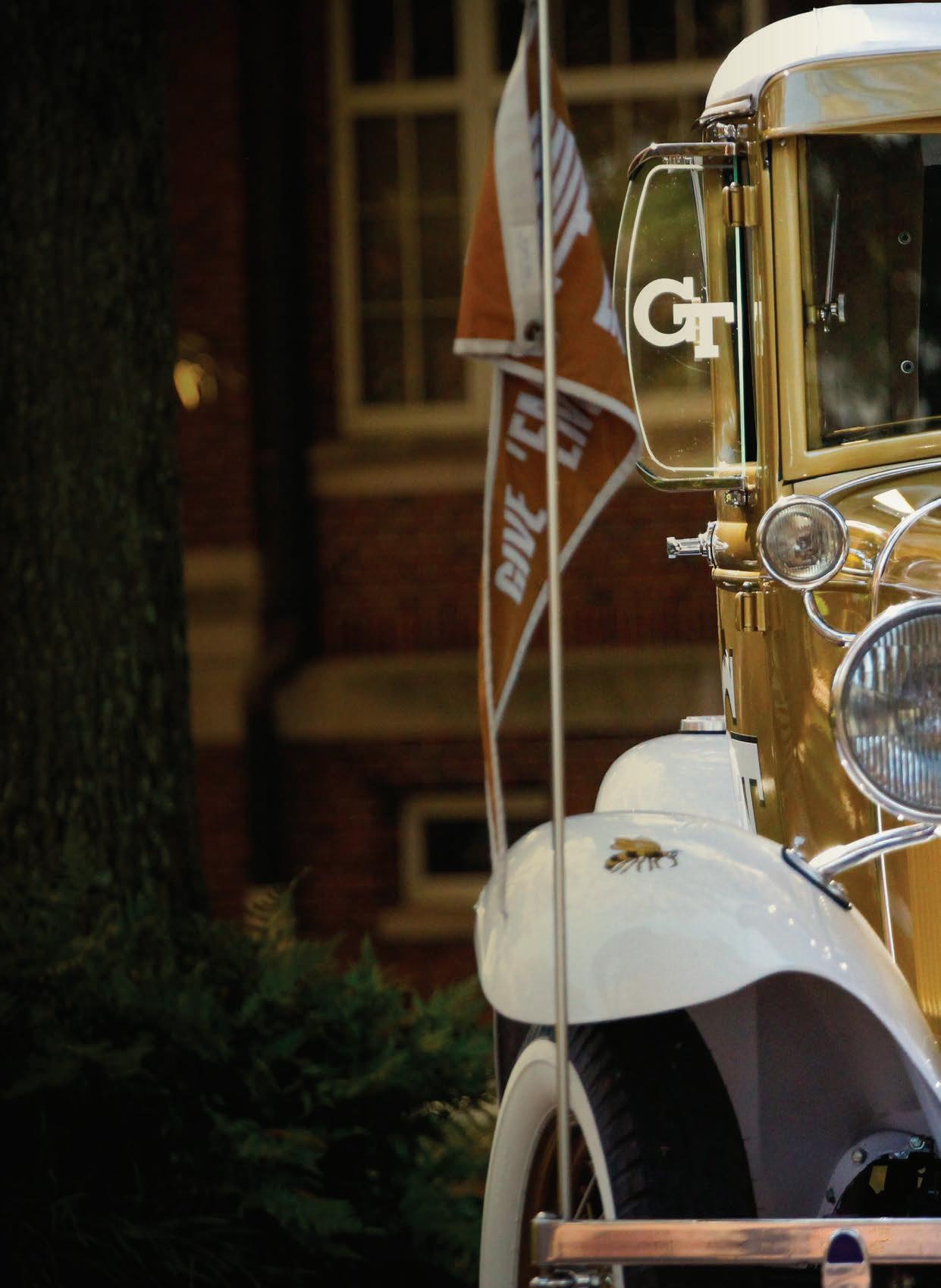


An incredible $8.3 million was contributed during the 78th Roll Call—a powerful testament to the unwavering support and pride of the Georgia Tech community! Roll Call has provided crucial unrestricted funding to support student needs, scholarships, and programs since it was founded in 1947 when the Institute faced a dire lack of funding a er World War II.
1,351 donors gave for the first time during the 78th Roll Call


19,986 donors kept their giving streak alive as part of the 1885 Consecutive Giving Society



2,277 donors have given for 50+ consecutive years 91% of gi s were below $1,000 $100 was the most common gi amount

2,288 households participated in Leadership Circle

15,350 donors were alumni


155 ambassadors volunteered their time to promote Roll Call
THE 2025 CLASS of the Georgia Tech Alumni 40 Under 40 program proves that Yellow Jackets elevate excellence and leave a lasting impact on the world. ey are improving the quality of drinking water, harnessing AI to transform healthcare, revolutionizing renewable energy, and solving complex challenges across industries. Learn about three honorees who are leaving their mark on the space and aviation industries and read more about all the Tech honorees at GTalumni. org/40under40.


Senior Manager, Commercial Sales Space Exploration Technologies (SpaceX)
FAVORITE
TECH MEMORY: Road-tripping down to see the final launch of Space Shuttle Endeavor with friends and my now-husband, David!
Ronnie Foreman is a senior manager for Commercial Sales at SpaceX, where she has worked on the company’s innovative small satellite Rideshare Program for the past five years. Foreman is a regular launch webcast host, providing live coverage of satellite and astronaut missions. She began her career at NASA Goddard, in Maryland, researching satellite constellations as part of her graduate thesis. After earning two master’s degrees from MIT, she joined Virgin Orbit as a payload integration engineer, supporting the development of the first air-launched liquid-fueled rocket. As a parabolic flight coach for ZeroG, Foreman has accumulated more than 80 minutes in microgravity.


















Counsel, House Subcommittee on Aviation
U.S. House of Representatives
FAVORITE TECH MEMORY:
Touring with the Glee Club through the U.K., before flying to Brussels for my study abroad in the EU.
Adam Weiss is counsel for the Subcommittee on Aviation in the U.S. House of Representatives, where he advises Congress; conducts oversight of the FAA, NTSB, and aviation industry; and was part of the team that drafted the 2024 FAA Reauthorization. He is also a lieutenant, junior grade in the U.S. Navy Reserve. Before Capitol Hill, Weiss was an engineer at Boeing: Phantom Works, where he worked on prototype spacecraft such as the Starliner. Weiss has a bachelor’s in aerospace engineering and a bachelor’s in international affairs from Georgia Tech; has a J.D. from The George Washington University; and is pursuing a master’s in defense strategic studies from the U.S. Naval War College.













Deputy Director, Strategic Initiatives Group U.S. Space Force

Kaitlyn Johnson is the deputy director of the Chief of Space Operations’ Strategic Initiatives Group for the U.S. Space Force. In this role, she advises on Space Force strategic messaging, institutional policies, change management, organizational development, and space strategy. Before this, Johnson was a deputy director and fellow of the Aerospace Security Project at the Center for Strategic and International Studies. There, she specialized in topics such as space security, military space systems, and commercial and civil space policy. She is widely published on national security space reorganization, space threats, commercial space, escalation and deterrence dynamics, and cislunar activities.
FAVORITE TECH MEMORY: European Union study abroad with my best friend!

OLIVIA MARIA AMYETTE, CS 20
Founder/CEO | Infinite Energy Advisors, Solar Knowledge Institute

ALLISON BERNARD, CE 09 Project Development Director | NextEra Energy Resources

PARMINDER BHATIA, MS CSE 15 Chief AI Officer | GE HealthCare


ANISH BHATT, IE 10 VP Product | Jeeves


KYLE BLOND, AE 12
Senior Research Engineer and Branch Head | Georgia Tech Research Institute Logistics Company Commander | U.S. Marine Corps Reserve

BRANDI BROWN, BIO 13 Founder/CEO | Gulf Spore

USAYD CASEWIT, MS PP 17 Team Facilities Officer | FIFA


KEVIN CONE, ME 10
Assistant Athletic Director, Student-Athlete Development | Georgia Tech




SHANNON EVANCHEC, ENVE 16 CEO | TruePani

RONNIE FOREMAN, AE 14
Senior Manager, Commercial Sales | Space Exploration Technologies (SpaceX)




VICTORIA FRITZ, BIO 17 Founder/CEO | BabyBumps

MITCHELL HANSON, NEUR 20
MD/MPH Student | Medical College of Georgia




JOE HARMS, MS MP 15, PHD NE 18
Assistant Professor/ Medical Physicist | Washington University in St. Louis




SAMUEL HARRIS, CE 12, MS CE 14
Assistant State Traffic Engineer | Georgia Department of Transportation




ADAM HASHAM, MS CS 24
Lead AI/ML Engineer | Vizient


ROBERT HERBERT, PHD ME 22
Assistant Professor | Louisiana State University




DAVID HERN, MGT 08, MBA 12 CEO | Sofer Advisors, LLC




KAITLYN JOHNSON, IA 14
Deputy Director, Strategic Initiatives Group | U.S. Space Force

ANKIT KAUSHIK, BME 14, MS ECE 22
Senior Technical Product Manager | Smarsh




GOKUL KUMAR, MS ECE 10, PHD ECE 15
Senior Director | Micron

DAVID LEBER, CHBE 14, MS CS 21
Vice President of Data Science | Preston Ventures




JUNG HYUN LEE, MS BC 18, PHD BC 22
Assistant Professor | SUNY Farmingdale State College




NICK AUSTIN LEE, MS CS 17
Lead Product Manager for Unstructured Data | Disney Experiences




PJ LYNN, BME 08
Medical Director | Atrium Health




MEAGAN CLEM MARTZ, IAML 08, MS IA 11
Senior Associate Director, Lead—International Leadership Giving | The Carter Center

AKANKSHA MENON, MS ME 15, PHD ME 18
Assistant Professor | Georgia Tech


CAROLINE GWYNN MONAGLE, STC 14
Vice President, Strategic Initiatives | R1 RCM

MICHAEL MORELAND, IA 07
CEO | Field Intelligence, Inc.

SHAY NATARAJAN, ME 09, MS ME 12 Partner | Mobility Impact Partners




KRYSTAL PERSAUD, ID 10
Design Innovation Lead | Spin Master Inc. Inventor | Grouphug Solar


ERIC PIERCE, PHD BME 18
Director, Engineering | Edwards Lifesciences


TANAY RAJORE, IE 14 Director | PwC

LIZ RAMANGRUBBS, BA 17
Founder | Supply Chain Gals

ANTHONY ROJAS, CHEM 14
Senior Academic Professional | Georgia Tech




NICOLE SEEKELY, ARCH 07
Senior Project Architect | Perkins&Will




SONA SHAH, CHBE 11 CEO | Neopenda




J. DANIELLE SHARPE, HTS 14
Epidemiologist | Centers for Disease Control and Prevention




ALEXANDRA SLACK, MS PP 22
President & COO | National Education Equity Lab




CHRISTOPHER R. VALENTA, MS ECE 10, PHD ECE 14 Principal Research Engineer | Georgia Tech




ADAM C. WEISS, AE 10, IA 10
Counsel, House Subcommittee on Aviation | U.S. House of Representatives

WAYNE MOTE, CE 89, WASN’T EXPECTED TO RECOVER AFTER A MAJOR MEDICAL EMERGENCY STOPPED HIS HEART FOR 22 MINUTES.
BY JENNIFER HERSEIM
IN APRIL 2022, Wayne Mote, CE 89, was running a sprint triathlon when he went into cardiac arrest. As a lifelong athlete, a former Georgia Tech offensive lineman, and an Ironman triathlete, he wasn’t expecting any issues during the sprint. His heart stopped for 22 minutes. Medical
personnel were able to resuscitate him, but the lack of oxygen to his brain caused a global anoxic brain injury and he was on life support for months. With the love, faith, and support of his wife and a group of dedicated Tech friends and former classmates, Wayne beat all the odds. He made
it through the first days, weeks, and months at the hospital, then more months of intensive therapy at the Shepherd Center, an Atlanta-based nonprofit specializing in brain and spinal injuries. His wife and fellow Yellow Jacket, Lori, focused on getting him to respond.
“With a brain injury, you’re focused on trying to get a reaction of any sort,” Lori, Text 91, says. One moment during Wayne’s therapy stood out. “During one of the Shepherd Center sessions they played the Ramblin’ Wreck fight song, and he responded. He started tapping his foot and singing along.”
Three years after the accident, Wayne’s road to recovery has been long and complicated. His brain injury impacts his speech and mobility, and his needs can change day to day. A core group of seven alumni— friends of the Motes—have stepped in to lead support. They established the Mote Care Fund, where many have donated, allowing for major renovations to the Motes’ home, specialized ongoing therapy, and vehicle accommodations.
Wayne, who was an offensive lineman for the Jackets in the ’80s, has always been athletic, and that hasn’t changed, even with his accident. “At the Shepherd Center, he maxed out the leg machines. There’s no machine ready for a guy that’s 6'5",” says Larry Ragan, IE 86.
Ragan is part of the care team supporting Wayne, along with Helen, Mgt 89, and Kenny Smith, IE 90; Cindy, IE 90, and Thomas Rainey, CE 88, MS CE 92; and Kelli, IE 90, and Todd Long, CE 89, MS CE 90. The group bonded through their church community. “Wayne’s beat all the odds. He shouldn’t have had any use of his legs. He shouldn’t have communicated. The sheer willpower of him has beat all the odds,” Ragan says.
Lori and Wayne met in church while students at Tech. “Our pastor said
turn to the person next to you and introduce yourself, so I turned to Wayne and said, ‘Hi I’m Lori.’ This was the start of the spring quarter, and the very next day he was in my calculus class at Tech,” Lori says.
The young couple spent time together usually before or after Wayne’s football practices and attended “Friday Night Live” social events through Campus Crusade for Christ. They formed lifelong friends. “There are about 20 of us who still vacation and get together decades later,” Lori says. After Wayne graduated (Lori had a year to go in her co-op), the two married on April 1, 1989. “They’re always thinking about others,” says Ragan, who remembers how Lori sent him a card on the oneyear anniversary of his father’s death. “They’re the type of people who give and care.”
In the first few months after Wayne’s accident, Lori looked to the care group for guidance. On Wayne’s birthday, a month after his accident, they went to The Varsity restaurant in his honor and the conversation turned grave. “We were discussing whether to pull him off life support,” Lori says. “It was really heavy.”
A year later after a grueling recovery, Wayne was able to join his family and friends at The Varsity. Since then, the annual Varsity birthday trip has become a tradition. At the most recent one, three years after the accident, Wayne and Lori posed for a photo surrounded by his care team. Also there were three of their four children and the couple’s friends. Wayne lifted his hand to cheer, “Go Jackets!”
To donate to the Mote Care Fund, contact Larry Ragan, coordinator, at blragan@icloud.com.
BRYN BYERS, ARCH 94, is the facility project and design manager for Southeast Toyota Distributors in Deerfield Beach, Fla. Byers began his automotive design career with Gensler in Atlanta before moving to South Florida in 2011 to work directly with SET and its 178 dealerships across the five southern states.



MELISSA CANTRELL, ARCH 96, M ARCH 99, was reappointed by Georgia Gov. Brian Kemp to the Georgia State Board of Architects and Interior Designers.
JIMMIE L. DAVIS JR., EE 92, MS MATH 95, was recognized at the 39th BEYA STEM Conference in February with the Career Achievement in Industry Award.
TIM LIEUWEN, MS ME 97, PHD ME 99, Georgia Tech’sexecutive vice president for research, received the 2025 Dedicated Service Award from the American Society of Mechanical Engineers. The award honors dedicated voluntary service to the society.




DARRYL LUNON, CE 99, was named associate vice chancellor, senior counsel, and chief of staff to the general counsel at Vanderbilt University. Previously, he worked in higher education law at Georgia Tech and Penn State and served for over 14 years in the U.S. Army. His contributions to the legal profession were recognized earlier this year with the National Association of College and University Attorneys’ First Decade Award.
MICHAEL LORNE, HPHYS 93, finished second place for the second year in a row in the Senior Men Longboard division at the USA Surfing Championships. Lorne resides in Haleiwa, Hawaii, and traveled to North Harbor Jetty in Oceanside, California, to compete in the tournament this June.


CHARLES LEE ISBELL JR., ICS 90, has been named the 11th chancellor of the University of Illinois UrbanaChampaign and vice president of the
WILLARD SCISSUM, CE 23, MS CE 24, was the keynote speaker at the 2025 STEM Academy at Georgia Tech Banqueton June 6. The weeklong STEM-themed summer camp for high schoolers was a collaboration between the Atlanta Area Council and Georgia Tech. Scissum, who played on the Georgia Tech Football team, spoke about the impact of STEM on his life.
University of Illinois System, assuming his new role August 1. Isbell, a leading computer science expert, served as associate dean and then dean of Georgia Tech’s College of Computing for more than 20 years. He oversaw a period of intense growth at the computing college, including the launch of the first-of-its-kind Online Master of Science in Computer Science program. He became provost of the University of Wisconsin-Madison in August 2023.

ANNE McGRAW, MGT 99, was named the first-ever chief marketing officer for Hattie B’s Hot Chicken. The position was created as the Nashville-based company expands to new markets nationwide.







MUSSER, CE 87, MS CE 89, retired from his job as a hydrologist after more than 35 years with the U.S. Geological Survey. Musser was based in Georgia and worked on Georgia Tech’s campus from 1991 to 2004.
SAVANNAH SKRAM, CHBE 19, was awarded a 2025 Emerging Leaders MAKE award for her work as an industrialization engineer at Arkema. This award recognizes women under 30 who have demonstrated leadership and made significant contributions early in their careers.




FRED SLONE, MS IM 79, published his first law review article, “Default Is No Option: The Unconstitutionality of the Debt Limit Law,” in the UC Law Constitutional Quarterly, Volume 52, Issue 4. Slone is a former Georgia Tech faculty member and is a member of the State Bar of Georgia.
ANNE K. SMITH, ARCH 85, was reappointed by Georgia Gov. Brian Kemp to the Georgia State Board of Architects and Interior Designers.



FLOCK SAFETY, founded by Georgia Tech alumni



KOFI SMITH, IE 99, MBA 09, was named board chair of Goodwill Industries International. Smith, CEO of Keystone Management, LLC, also serves on the advisory board of the Georgia Tech Scheller College of Business and the board of trustees for the Alumni Association.
DAVE WILLIAMS, MGT 89, has been promoted to chief policy officer at the Metro Atlanta Chamber. He joined the Metro Atlanta Chamber in 2011.
THE WALL STREET JOURNAL published its inaugural list of the top 250 influential corporate board directors who have served on S&P 500 boards through 2025, and four Georgia Tech alumni made the list:
#66 #92
Charles Moorman IV, CE 75, serves on the board of Chevron Oracle.
Rod Adkins, EE 81, MS EE 83, HON PhD 13, serves on the board of Avnet, United Parcel Service, and W.W. Grainger
#141 #233
Joseph L. Moskowitz, IM 75, serves on the board of Aflac.
John Brock, ChE 70, MS ChE 71, HON PhD 16, serves on the board of Royal Caribbean Group.

Garrett S. Langley, EE 09, Paige Todd, Mgt 07, Matt Feury, CS 11, and Bailey Quintrell, ME 10, was recognized as the No. 7 company on CNBC’s Disruptor 50 list. This was the first year that the company, a surveillance technology company founded in 2017, made the list.


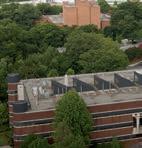




EACH YEAR, APPROXIMATELY 80 INDIVIDUALS are chosen to be part of Leadership Atlanta’s nine-month executive-level professional development series. The 2026 class includes the following Georgia Tech alumni:
Jayasree Amburkar, MBA 24, Managing director, Accenture
Donald Beamer, Econ 05, Senior technology advisor, City of Atlanta Mayor’s Office of Technology
Col. James Biggers, ICS 84, Colonel, deputy battle director, aircraft commander, flight instructor, aviation mishap investigator, United States Marine Corps
Alex Demestihas, BC 05, Managing director, North Avenue Partners
Danielle Donehew, IE 01, Executive director, Women’s Basketball Coaches Association
Saira Draper, PP 06, Georgia General Assembly, House District 90, State of Georgia
Kashi Sehgal, Cls 08, Founder and CEO of Retaaza
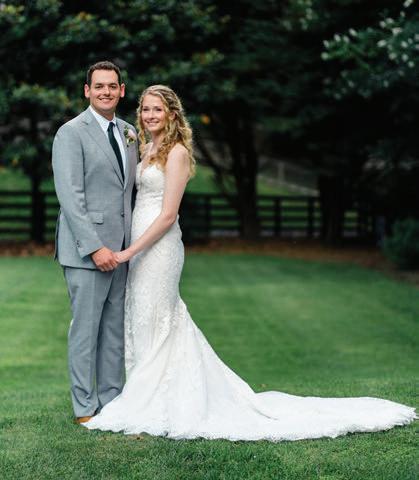


1. ANNA BENKESER, IAML 18, and DAVID ALMAN, AE 17, MS AE 18, were married on June 22, 2024.
2. JOANN (AHN) CRUZ, IE 22, and JOSHUA CRUZ, BME 22, were married in January at the Cathedral of Christ the King in Buckhead, Atlanta. Thanks to an RA, they met

their freshman year on the third floor of Towers Residence Hall and have been together ever since. The couple made sure to drive off in style after the wedding in the Ramblin’ Wreck.
3. HAYLEY TSUCHIYAMA, CHBE 18, and JONATHAN McKOWN, AE 18, tied the knot in May 2025 with the Alumni Wreck by their side.
4. MINH (NGUYEN) WILLIAMS, ARCH 21, M ARCH 24, and DEVAN WILLIAMS, CS 19, first ran into each other under the Tech Campanile as undergrads. The two were married in May in Atlanta.

5. SLOANE KYRAZIS, CE 18, and MATT ALMAND, CE 18, were married on May 10.
6

6. SYLVIE JEAN BLANTON, CHBE 25, and ALEXANDER FONZI, CS 22, were married June 7 at the Julia Thompson Smith
Chapel at Agnes Scott College. They met at Tech Wesley, and former campus minister Geoff Beakley, BME 94, officiated.

1. MEGNA SAHA, BME 15, and HAMILTON GREENE, CS 16, are excited to announce the birth of their daughter, Aarya Saha Greene, on June 19.
2. OLIVIA CENTENO, CHBE 15, and IRVIN CENTENO, ME 15, met at Georgia Tech 13 years ago and are now celebrating the birth of their first child, Oscar William Centeno, born July 8.


JOHN GUERARD, MS IM 77, is the author of The Leading Economic Indicators and Business Cycles in the United States.
In the next issue, the Alumni Association is celebrating Wrecks who have started their own businesses. Send us your on-thejob selfies at GTalumni.org/wrecksatwork.

Two past Georgia Tech Yellow Jacket Flying Club (YJFC) instructors are now flying together at Delta Airlines. James Dixon, Mgt 03, and Chris Burrus, IE 01, captured this photo in February from the cockpit heading to Atlanta from Chicago. Dixon is the captain on the left and Burrus is first officer pictured on the right. Burrus was president of YJFC from 2000 to 2001.

Sachin Shailendra, CE 00, former chairman of the University System of Georgia Board of Regents, is president of SG Contracting, which is restoring the historic House Chamber in the Georgia State Capitol. Shailendra is pictured adding finishing touches to a column on the inside of the Chamber.

Georgia Tech Professors Peter Swire and Annie I. Antón, ICS 90, MS ICS 92, PhD CS 97, taught a privacy course in the GT Barcelona Study Abroad program for computer science students. This summer, they asked architecture alumnus Javier Salman,Arch 86, MS Arch 88, to give a tour of privacy features in Barcelona architecture for the students. The class posed in front of Gaudi’s La Pedrera building with Salman standing between Swire and Antón, holding a Georgia Tech banner. Also holding the banner is Delaney Gomen, MS CS 24, their teaching assistant.
WE REMEMBER & HONOR THE FOLLOWING

Jose A. “Pepin” Bolivar, IE 49, of Guaynabo, Puerto Rico, on Nov. 16, 2023.
Donald E. “Don” MacCullough, IM 48, of North Miami Beach, Fla., on April 5.
Franklin H. “Pat” Pond, ME 47, of Little Compton, R.I., on March 8.
John L. Stanley, ChE 47, of Port Orchard, Wash., on Sept. 21, 2023.
James R. Bates Jr., IE 59, of Elizabethtown, Ky., on April 11.
William E. “Billy” Beckham Jr., IM 58, of Perry, Ga., on May 31.
Thomas W. “Tom” Cadden, ChE 56, of Vero Beach, Fla., on March 31.
Clarence C. Cadenhead, EE 51, of Snellville, Ga., on March 25.
Antonio M. Carrillo, ChE 58, of Baton Rouge, La., on March 24.
James R. Chamberlain Jr., Arch 53, of Chattanooga, Tenn., on April 25.
Robert L. Daugherty, IM 58, of Largo, Fla., on June 17.
Robert H. “Bob” Davis, ME 55, of Smyrna, Ga., on Nov. 22, 2023.
William E. “Bill” Dean, AE 52, of Meadowlakes, Texas, on April 10.
CHARLES “CHARLIE” HARRISON, IM 52, OF ATLANTA, ON JULY 15. Harrison’s passion for golf began early, nurtured by the mentorship of the legendary Bobby Jones. By 1947, Harrison had won the Atlanta City Junior Championship. After graduating valedictorian from Marist School, he went on to letter in golf for four consecutive years at Georgia Tech.
A lifelong amateur, Harrison enjoyed a storied career: He won the Atlanta Amateur a record 10 times, the Atlanta Athletic Club Championship 10 times, and the Atlanta Country Club Championship six times. He also claimed titles at the 1955 Southern Amateur and the 1959 Georgia Amateur. In 1966, he was ranked the 13th-best amateur golfer in the country, and in 1967, was named an alternate for the U.S. Walker Cup team. Harrison qualified for the U.S. Amateur 16 times, reaching the quarterfinals in 1959 and finishing fifth in 1972. He was a quarterfinalist in the 1980 British Amateur and competed twice in the Masters Tournament at Augusta National.
He served as a director of the Southern Golf Association and was president of the Atlanta Golf Association from 1971 to 1985. He was inducted into the Georgia Tech Hall of Fame in 1978 and the Georgia Sports Hall of Fame in 1991. He reclaimed the East Lake Club Championship title in 2003, four decades after first winning it in 1964. In recognition of his enduring impact on the game and the community, East Lake Golf Club named its caddie scholarship in his honor—fondly known as the Harrison Scholarship.

Harrison began his professional career with Adair Realty and later worked in the insurance industry with Bill Leide of Leide Associates. A visionary and beloved figure in the East Lake community, he helped found the East Lake Junior Golf Academy and later, The First Tee of East Lake, bringing “Golf With a Purpose” to life in the heart of his neighborhood. Alongside his devoted wife, Sylvia, he established the Charles W. Harrison Scholarship Fund, which for decades has supported East Lake Golf Club employees, caddies, and Drew Charter School students in pursuing higher education and giving back to their communities— just as he always did.
He is survived by his wife of 45 years, Sylvia Hollis Harrison, his daughter Molly Harrison Smith (Dutch), his stepson Robert “Trey” Clark Rudder III (Andrea), granddaughters Jennifer Geeker (Thomas) and Sarah Rudder, sister-in-law Sandra Kellner, niece Leigh Dobbs (Willis), nephew Jared Paul (Kelley), great-nephews Jack Dobbs and Hollis Dobbs, and great-grandson Clark Geeker. He was preceded in death by his parents, Louise and James Lawrence Harrison Jr., his brother, Father James “Jim” Harrison, and his daughters Cary Cox Harrison and Helen Michael Harrison.
Peter “Pete” Dragan, CE 55, MS CE 58, of Naples, Fla., on Nov. 6, 2024.
James C. “Jim” Edenfield, IE 57, of Atlanta, on April 16.
Donald “Don” Erlenkotter, CE 59, of Santa Monica, Calif., on Jan. 14, 2024.
Gerald W. Fletchall, ME 57, of Jacksonville, Fla., on June 11, 2023.
James E. “Ed” Garrett, CE 54, of Gainesville, Ga., on Aug. 3, 2024.
John H. Hellweg Jr., ChE 55, of Greenville, Wis., on Sept. 2, 2023.
Leslie J. Horn, Phys 58, of Eagle River, Alaska, on March 17, 2023.
James R. “Jim” Ingram, Arch 59, of Black Mountain, N.C., on April 23.
Charles S. Johnson Jr., Chem 58, of Chapel Hill, N.C., on April 28.
Frederick R. “Fred” Keith Jr., IM 57, IE 58, of Asheboro, N.C., on May 13.
George O. Kelbert, AE 52, of Saint Augustine, Fla., on March 13.
WARD O. WINER, OF ROSWELL, GA., ON MAY 25 . A distinguished Regents’ Professor Emeritus in the George W. Woodruff School of Mechanical Engineering, Winer’s contributions to mechanical engineering and his unwavering dedication to Georgia Tech have left an indelible mark on the Institute and its people.
Winer began his academic career at the University of Michigan. In 1969, he came to Georgia Tech, where he spent nearly 40 years until his retirement in 2008. From 1989 to 2008, Winer was the longest-serving chair of the Woodruff School. After retirement, he was asked to return as the interim chair of the School of Civil and Environmental Engineering for a year, and he continued part-time at Tech until 2019. He maintained his involvement on national and international boards until 2023.
Winer’s research spanned tribology,

fluid mechanics, high-pressure rheology, lubrication, thermomechanics, and machinery diagnostics. Notably, he led a Department of Defense (DoD) Multi-University Research Initiative focused on integrated diagnostics of machinery, a testament to his innovative approach to engineering challenges. Other research projects under Winer’s direction were funded by companies from the petrochemical industry, the National Science
Arthur J. “Art” Kunzer Jr., Text 54, of Gainesville, Ga., on March 28.
John H. Langford, AE 59, of Houston, Texas, on May 26.
Charles M. McQuaid, ME 50, of Jacksonville, Fla., on March 19.
Jefferson H. “Jeff” Milner, CE 57, of Crawfordville, Ga., on June 15, 2023.
J. V. “Vernon” Nicodemus Jr., Text 57, of Atlanta, on March 26.
George E. Perkins, Arch 50, of Augusta, Ga., on June 15, 2024.
Foundation, the National Aeronautics and Space Administration, the Office of Naval Research, and the DoD.
Winer’s academic career was marked by numerous honors and awards, including election to the National Academy of Engineering in 1988 and as a Fellow of the American Society of Mechanical Engineers and the American Association for the Advancement of Science, underscoring his profound impact on his field. He also received the Georgia Tech Distinguished Professor Award and the Sigma Xi Monie A. Ferst Memorial Award for Sustained Research.
Ward is survived by his wife of 67 years, Mary Jo Wielinga Winer; his children, Matt, Jim, Paul, and Mary; and13 grandchildren and two great-grandchildren.
—Ashley Ritchie, George Woodruff School of Mechanical Engineering
Thomas M. Phillips, EE 52, of San Diego, Calif., on Feb. 15.
James P. Rabun, IM 53, of Marietta, Ga., on March 14.
Patrick H. Rice III, IM 56, of Augusta, Ga., on March 29.
Alan H. “Buddy” Rubinson, IM 55, of Atlanta, on April 19.
Robert W. “Bob” Schnepfe, ME 56, of Rehoboth Beach, Del., on March 28.
Abbie G. Schuler, IM 57, of Austin, Texas, on July 8, 2024.
Owen O. Schweers Jr., ME 59, of Salisbury, Md., on March 19.
John M. Shirley, Text 59, of Lawrenceville, Ga., on April 6.
Roy M. Simon Sr., Arch 52, Arch 52, of Delray Beach, Fla., on Aug. 14, 2024.
James S. Sledge, Cls 50, of Monticello, Fla., on April 27.
RICHARD “DICK” LAWRENCE FRAME, IM 62, of Macon, Ga., on May 29. While at Georgia Tech, Frame was a member of the track team, a member of Sigma Alpha Epsilon fraternity, and vice president of the student body. He excelled in the 220-yard hurdles, sprints, relays, and long jump. His love for Georgia Tech never wavered throughout his life. He was proud that he was on the committee that was formed to find the first Ramblin’ Wreck car. He proudly sported gold and white, cheering on his team no matter the season. One of his greatest joys was watching three of his children and three of his grandchildren attend his alma mater.
After graduating in 1962, Frame joined the U.S. Coast Guard. In 1963, he married the love of his life, Mary “Marty” Truett Jackson, of Montgomery, Ala. After her graduation from Agnes Scott, they moved to Macon, and he began a 43-year career as a Sales Engineer with The Trane Company. The last 16 years he had the privilege of working alongside his son, Rick. He and Marty loved to travel and together built a life full of faith, laughter, and love, raising four children:
Rick, Jacki, Jeff, and Taylor, instilling in them the same determination and humility he brought to every aspect of his life.
Committed to civic engagement, Frame was a member of Vineville United Methodist Church, where he was in the Webb Fellowship Sunday School class, served on the board, and ushered for many years. He was a member of the first Leadership Georgia Class in 1972, past president of the Macon SAE Alumni Association, and a member of the Macon Civic Club, where for many years he enjoyed performing in the annual variety show. He served in many capacities at Vine-Ingle Little League.

For over 40 years Dick was a volunteer track coach at First Presbyterian Day School (FPD). He also served as the official State Starter for the GISA state track meet from 1982 to 2010. In 2000, he was awarded the T. Sam Burke award by the Macon Telegraph for Service to High School Sports. In
2010, FPD awarded him the Outstanding Service Award for his contributions to the school with his coaching skills. In 2016, he was inducted into the Macon Sports Hall of Fame, and in 2018, he was honored by the Georgia Sports Hall of Fame with the Taz Anderson Award. He left a legacy of service to FPD, which was commemorated in 2014 when they honored him by naming the track the Dick Frame Complex. FPD also hosts the Dick Frame Track Invitational each year in the spring. He is survived by his loving wife of over 61 years, Mary “Marty” Truett Jackson Frame; his children, Richard “Rick” Lawrence Frame Jr. (Cheri) of Macon, Mary Jackson “Jacki” Frame Spivey (Scott) of Macon, Jeffrey “Jeff” Truett Frame of Prague, Czech Republic, and William “Taylor” Frame (Keeb) of Atlanta; seven grandchildren; his sisters-in-law; and many nieces and nephews. He was preceded in death by his twin brother, Steve Frame, and younger brother, David Frame.
George W. Stone Jr., AE 59, MS AE 60, of Portland, Ore., on March 11.
John L. Teramo, CE 57, of Lynbrook, N.Y., on April 17.
Ronald C. Tucker, IM 56, of Gainesville, Ga., on May 22.
Wendell M. Williams Jr., ME 55, of Atlanta, on April 2.
William J. “Jack” Yaggi, ChE 52, of Knoxville, Tenn., on March 24.
Henry J. “Jim” Barber, IM 64, of Beaufort, S.C., on May 10.
John L. Barner Jr., IM 60, of North English, Iowa, on Sept. 13, 2023.
Frank L. Bartholomew III, IM 62, of Atlanta, on March 21.
James H. Bell Jr., IM 65, of Atlanta, on Aug. 31, 2023.
Ronald J. Birdseye, AE 66, of Marietta, Ga., on April 6.
Homer L. Black, IM 66, MS IM 78, of Mableton, Ga., on Feb. 10.
David F. “Dave” Blanchard, CE 66, of Radium Springs, N.M., on March 16.
Maurice J. Bouvier Jr., PhD EE 68, of Port Saint Lucie, Fla., on May 18.
John Brendus Jr., ME 61, of Massillon, Ohio, on May 27.
Oliver L. “Ollie” Brown, IE 62, of Kathleen, Ga., on June 26, 2024.
George A. Burtz, IM 60, of Newnan, Ga., on March 28, 2023.
William W. “Bill” Childress Jr., IM 69, of The Colony, Texas, on Jan. 24, 2024.
John W. Cline, IM 69, of Huntsville, Ala., on May 20.
Michael B. “Mike” Danzig, IE 63, of Chardon, Ohio, on April 27.
Daniel C. DeCarlo, IE 61, of Tucson, Ariz., on March 23.
Larry S. Dillard, CE 60, of Birmingham, Ala., on May 11.
William E. “Bill” Dobson, IM 67, of Olive Branch, Miss., on July 15, 2024.
James Q. Evans, EE 69, of Cumming, Ga., on April 28.
Robert W. Faulkender, MS IE 67, of Melbourne, Fla., on Nov. 28, 2024.
Donald B. Fay, EE 65, of Huntsville, Ala., on April 30.
Robert B. Foster, MS ME 68, of Colorado Springs, Colo., on June 5.
Charles D. Garner Jr., ME 67, of Newnan, Ga., on April 12.
Doyle F. Garrett, ChE 64, of Boca Raton, Fla., on Aug. 8, 2023.
Peter L. Ginocchio, ME 61, of Melbourne, Fla., on March 31.
Donald M. “Don” Grogan, IE 60, of Cumming, Ga., on Feb. 1.
William T. Hardy, EE 67, of Fairfax Station, Va., on March 30.
Jerald P. Hart, IM 65, of Marietta, Ga., on Oct. 25, 2023.
Melvin T. Hefter, CE 65, of Cocoa Beach, Fla., on July 24, 2024.
Donald R. Hodges, IE 61, of Panama City, Fla., on April 13.
Byron E. Hodnett, IE 67, of Ponte Vedra Beach, Fla., on March 24, 2024.
Thomas E. Hogan, CE 62, of Dallas, Texas, on May 13, 2023.
Michael H. Iversen, IE 67, of Richmond, Texas, on April 8.
Thomas D. Jones, ChE 69, of Beaumont, Texas, on Sept. 1, 2023.
Edward N. “Ed” Kashuba, M CRP 69, MS CE 69, of Raleigh, N.C., on May 16.
Reine Liedtke, MS EE 69, of Jacksonville, Fla., on March 11, 2023.
John D. Looney, ChE 67, of Fairport, N.Y., on March 24.
Rufus Y. McAden III, IM 63, of Trent Woods, N.C., on June 21.
David S. McCowen, Arch 68, of Atlanta, on April 28.
Bruce J. McDonald, IM 67, of Atlanta, on April 19.
Donald O. “Don” McIntyre Jr., AE 69, of Loveland, Ohio, on April 25.
Jon M. “Michael” Morris, IE 68, of Tampa, Fla., on May 12.
John H. Moss, ME 60, of Easley, S.C., on April 16.
Jerome K. “Jerry” Owen, IM 69, of Keller, Texas, on May 29.
Thomas C. Peacock, CE 69, of Eastman, Ga., on Feb. 22.
George L. Pettigrew, MS NE 69, of McKinney, Texas, on Nov. 14, 2023.
Edward E. Pickard, Arch 60, of Honolulu, Hawaii, on Jan. 25, 2024.
George R. Pollard, Cls 62, of Cedar Hill, Texas, on May 8.
Thomas A. Pylant, EE 65, of Roswell, Ga., on June 22, 2024.
William D. “Bill” Reynolds, BC 61, of Tucker, Ga., on May 18.
Richard J. “Dick” Rogen, IM 65, of Solon, Ohio, on March 16.
Charles F. Rogers, CE 66, of Roswell, Ga., on June 1.
Michael O. Schliessmann, ME 68, MS ME 72, of North Chesterfield, Va., on May 8, 2024.
Hal Smith Jr., ChE 62, of Greenville, S.C., on April 11.
Hardy J. Smith, EM 62, MS CE 67, of Opelika, Ala., on April 8.
John D. Taylor Jr., IM 67, of Franklin, Tenn., on March 26.
Hue I. Thomas III, IM 64, of Savannah, Ga., on March 26.
Robert N. “Bob” Trebits, Phys 65, MS Phys 67, PhD Phys 72, of Lake Mary, Fla., on May 22.
Harvey B. Vereen, IM 68, of Moultrie, Ga., on April 18.
Russell L. “Russ” Ware, CE 66, of Canton, Ga., on March 20, 2023.
Clarence E. Williams, IM 64, of Charlotte, N.C., on March 31.
Robert R. “Bob” Winchester, ME 60, of Raleigh, N.C., on May 12.
Richard A. “Rick” Woolf, IM 66, of The Villages, Fla., on Sept. 5, 2024.
Jerry L. Wyatt, AE 63, of St. Augustine, Fla., on June 5, 2024.
CHARLES T. “TED” BRASFIELD, III, CE 66, OF MOUNTAIN BROOK, ALA., ON JUNE 10. Brasfield was born on September 1, 1944, in Memphis, Tenn. He became an Eagle Scout in 1956 and graduated from Shades Valley High School in 1962. While at Georgia Tech, he was a member of Phi Gamma Delta social fraternity, where he met many of his lifelong friends. He received his MBA from Georgia State College.
Brasfield was in ROTC at Georgia Tech. Following college, he was in the U.S. Air Corps of Engineers for three years. He served as a lieutenant at Army Engine Command in Germany, 1968–1970, and as a captain at Army

Engineer Command in Vietnam in 1970–1971, where he received the Bronze Star.
In 1971, he joined Brasfield Sales, Inc., a manufacturers’ representative firm founded by his father. He was president from 1984 to 2015. He had
many friends within the utility industry throughout the country.
A dedicated Yellow Jacket, Brasfield was active for many years with the Birmingham Georgia Tech alumni network as well as with Vestavia Hills Baptist Church, Shades Valley Rotary Club, and the Alabama Council Eagle Scout Board of Review.
He is survived by his wife, Jeannie Tharpe Brasfield, his brother-in-law, Robert “Bob” Batson, and nieces Michelle B. Long (Jeremy) and Jennifer B. Sellers (Chad). He was preceded in death by his parents, Joseph D. and Jane T. Brasfield, and by his sister, Susan Love Batson.
Phillip M. “Mike” Allred, MS Bio 76, of Bishop, Ga., on May 6.
Catherine R. Arey, MS IM 78, of McDonough, Ga., on May 8, 2024.
Milton F. “Frank” Arthur, AE 71, MS AE 74, of Melbourne, Fla., on April 8.
Robert M. Ball, Chem 71, of Corpus Christi, Texas, on April 20.
Ronald J. Bartlett, EES 76, of Ponce Inlet, Fla., on March 31.
Robert K. Bond, Bio 73, of Blue Ridge, Ga., on March 28.
Wallace P. “Wally” Buran, IE 75, MS IE 78, of Marietta, Ga., on May 19.
Charles E. Carrington, MS IM 75, of Pine Bluff, Ark., on March 17.
Walter J. Chrobak, MS IE 71, of Manassas, Va., on April 1.
Anthony C. “Tony” Ciampaglio, ME 76, of Sykesville, Md., on May 7.
David B. “Barry” Cotter, IM 77, of McDonough, Ga., on July 15, 2023.
John E. Counts, MS ICS 71, MS IM 71, of Morgantown, W.Va., on March 27.
Ronald B. Currens Jr., MgtSci 72, of Atlanta, on April 30.
James W. Dukes Jr., IM 76, of Rutledge, Ga., on April 30.
George P. Edwards, IM 74, of Saint Simons Island, Ga., on April 2.
Adel Farid, ME 79, of Decatur, Ga., on Sept. 4, 2023.
Andrew S. Foster, ME 75, of Stuart, Fla., on July 5, 2024.
Marguerite Frick, IM 76, of Austell, Ga., on July 4, 2023.
Keith W. Garber, IE 73, of Cary, N.C., on April 1.
Hubert F. Groseclose III, IM 72, of Douglasville, Ga., on April 28.
Ronald F. Holcombe, CE 70, MS CE 71, of Maricopa, Ariz., on May 6, 2023.
Ralph A. Hoover, AE 71, MS AE 73, of Tooele, Utah, on May 25, 2023.
Roger E. Huntington, Cls 76, on May 23, 2014.
Aaron N. Ingram, ChE 77, of Canton, Ga., on June 19.
Albert B. Jiu, Arch 76, of Rogers, Ark., on Oct. 23, 2023.
Ernest L. Johnson III, MS Math 72, of Richmond, Va., on April 8.
Stephen M. Johnson, IE 71, of Baton Rouge, La., on March 26, 2023.
Donald A. Kluthe, IE 73, of Naples, Fla., on June 3.
Leo A. Kramer Jr., MS AE 74, of Sanford, Fla., on Oct. 8, 2024.
Andre J. “John” Mallory, ChE 73, of Fairhope, Ala., on April 13.
Bernard J. “John” Maloney, IM 70, of Roswell, Ga., on March 5.
Jackie L. Martin, Arch 72, of Lawrenceville, Ga., on Aug. 7, 2023.
James V. “Jim” McGettrick, IE 71, of Vienna, Va., on Feb. 6.
John J. McKinney, MS IE 70, of Sherwood, Ore., on April 13.
Charles E. Newcomer, EES 78, of Fort Walton Beach, Fla., on March 18, 2023.
William R. “Bill” Nix, IM 79, of Alpharetta, Ga., on June 13.
Eric G. Olsen, Math 73, of Leander, Texas, on March 21, 2024.
Tim A. Peebles, ME 79, of Troutman, N.C., on April 27.
David E. Roesler, MS IM 74, of Huntsville, Ala., on May 26, 2023.
Alan J. Silver, IM 72, of Bay Harbor Islands, Fla., on May 11.
Charles O. Smith, Arch 76, M Arch 79, M CRP 79, of Winchester, Mass., on Jan. 31.
Steven A. Smith, Psy 74, of Rochester, Minn., on April 21.
Daniel M. St. Andre, MS ICS 79, of Covington, La., on Jan. 20.
Rodney M. “Rod” Tappen, IE 70, of Mount Laurel, N.J., on March 10, 2024.
James T. Varnadoe, IE 79, MS Mgt 84, of Miami, Fla., on Jan. 16, 2024.
William F. White Jr., PhD AE 73, of Kathleen, Ga., on May 15, 2024.
Richard D. Willett, Cls 78, of Lexington, Va., on May 14.
Larry W. Yarbrough, IM 72, of Dallas, Ga., on April 14.
Robert T. “Tom” Cooksey, IM 80, of Suwanee, Ga., on May 3.
Oscar Dayani, EE 89, MS EE 89, of Atlanta, on April 10.
David A. Dean, IM 85, of Marietta, Ga., on Jan. 22, 2024.
DONALD ELWIN LILLIE, PHYS 59, OF MARS HILL, N.C., ON JANUARY 6. Donald Elwin Lillie found his life’s calling when he got an apprenticeship in the glass lab at the Mayo Clinic in Rochester, Minnesota. He learned quickly, and soon caught the eye of glass company representatives, especially one from Corning Glass, who referred him to Wyatt C. Whitley, the acting chief of the Chemical Sciences Division at Georgia Tech. Whitley understood that Lillie was interested in continuing his college education (he had gone to junior college in Rochester) and offered him a part-time position as glassblower while he earned his degree at Tech. That started Don’s 30-plus-year career at Tech.
Being on Tech’s campus was a delight for him. He enthusiastically took part in the students’ extracurricular activities, even after his retirement. He drew energy and knowledge from his friendships with and mentoring of students, and especially anyone needing the help of the Glass Shop. One of his favorite stories involved a graduate student who needed a crucial piece of scientific glassware while he was on vacation: When he returned, the student teased him that he could have

graduated so much earlier if Lillie hadn’t been away. After starting out in Lyman Hall, his lab moved to a larger, state-of-the-art space in the new Boggs Chemistry Building.
Lillie was a lifelong Yellow Jacket fan, and even procured a 1931 Ford Model A, restoring it as his own Ramblin’ Wreck that he affectionately called “Binger.” He painted it black and gold to not infringe on the fame of the genuine vehicle.
In 1965, he started Lillie Glassblowers Inc., in Smyrna, Ga., and it’s now run by his son, Thom. He ventured from scientific apparatus into artistic glass, starting with a shop in Six Flags Over Georgia. He soon realized that glass trinkets and roller coasters are
not a great pairing! He moved on to other locations, including Underground Atlanta and the Galleria in Smyrna. The business continues to create custom awards for large corporations and small organizations but also, most proudly, the glass “Buzz” awards for retirees of Tech.
The American Scientific Glassblowers Society lists Lillie on the original 1957 Charter of the Southeastern Section. He served as ASGS president and ASGS Symposium chair, planned and hosted Society meetings in Atlanta, and presented papers at symposia across the country.
Although he retired from Tech in 1985, he didn’t slow down. Known as “Gaffer” (the name traditionally given to the eldest glassblower in the workshop), he focused on the family business, his growing family, and several hobbies, including building and flying radio-controlled aircraft.
He was preceded in death by his wife of 65 years, Maxine. He is survived by his daughter, Robyn Ratajczak (Tom, BChE 76), and son, Thom Lillie, grandsons Todd Ratajczak and Ross Ratajczak, granddaughter Camille Lillie, and four Ratajczak great-grandchildren.
Alan M. Deariso, Text 89, of Milledgeville, Ga., on March 31.
James R. “Jim” Dolan, IE 82, of Plano, Texas, on March 5.
Lucky O. Ehigiamusoe, CE 81, of Atlanta, on May 5, 2024.
William J. Ham, IE 84, of Bolingbroke, Ga., on May 29.
Stephen E. Kissling, ME 80, of Palmdale, Calif., on April 26.
Andrew W. Luck, CE 82, of Duluth, Ga., on Feb. 14, 2024.
Toney E. Means, IM 82, of Houston, Texas, on June 2.
Ronald C. Methier, MS GeoS 82, of Auburn, Ala., on March 17.
Charles E. Moss Jr., BC 80, of Savannah, Ga., on Dec. 30, 2023.
Robert J. Provan, EE 81, of Anchorage, Alaska, on March 27, 2023.
Richard M. “Rick” Rowland, EE 80, of McKees Rocks, Pa., on April 4.
Ki Y. Suh, MS EE 83, of La Crescenta, Calif., on April 28.
Raymond E. Yearty, MS Mgt 82, of Marietta, Ga., on March 14.
Paul R. Zeiders, CE 83, of McAlisterville, Pa., on April 23.
Christopher A. Baca, AE 95, of Memphis, Tenn., on Oct. 23, 2024.
Charles R. Berezin, PhD AE 95, of Trumbull, Conn., on June 17.
David P. Beshlin, MS CE 90, of Fayetteville, N.C., on March 16.
Heather D. Broome, M CRP 96, of Brookhaven, Ga., on May 5.
Kevin H. Butts, ME 96, of Smyrna, Ga., on April 27.
Todd J. Callantine, PhD IE 96, of San Bruno, Calif., on Dec. 9, 2023.
Ramona (Yu) Cargill, Chem 96, of Waycross, Ga., on March 19.
Douglas W. Deal, ChE 97, of Macon, Ga., on June 17, 2024.
Dixon F. Parker, NRE 91, MS HPhys 94, of Norcross, Ga., on March 10.
John W. Parker, IE 96, of League City, Texas, on May 13.
Martin J. Tuck, EE 98, of Lilburn, Ga., on April 6, 2024.
Patton M. Allison, AE 08, MS AE 09, of Okemos, Mich., on April 28.
James S. Dietz, PhD PP 04, of Elizabeth, Colo., on Aug. 15, 2023.
Jimmy D. Griffin, MS MoT 00, of Loganville, Ga., on March 21.
Peter J. Hardy, MS BCFM 05, of Libertyville, Ill., on April 28.
Jamieson X. Jones, IE 08, of Woodstock, Ga., on April 21.
James M. Murphy, CE 05, of Las Vegas, Nev., on June 5.
Roya Rostamian, MS CE 03, of Marietta, Ga., on Jan. 5, 2024.
Arthur F. “Franklin” Smith, Mgt 07, of Asheville, N.C., on May 21.
Samuel J. “Jason” Hooker, MS ME 10, of Cleveland, Tenn., on Aug. 23, 2023.
Hassan A. Kingravi, MS CS 10, PhD ECE 14, of Marietta, Ga., on Feb. 17, 2024.
For the In Memoriam section of the Georgia Tech Alumni Magazine, we will include an abbreviated version of each obituary in print. Full obituaries can be found at gtalumni.org/InMemoriam. To report a death, please email updates@gtf.gatech.edu
Lonnie L. McGee Jr., ME 12, of Burlington, Iowa, on April 28.
Adrian R. Mitchell, NRE 13, of New London, Conn., on April 20.
Eric D. Taylor, M MLDR 18, of Owens Cross Roads, Ala., on May 3.
Leonardo E. Hummel, M ID 20, of Seattle, Wash., on March 21, 2024.
Carolyn Barlow, of Atlanta, on March 24.
Tzyy-Jiann Bee, of Irvine, Calif., on April 10, 2023.
Linda Cooper, of Saint Simons Island, Ga., on Aug. 4, 2023.
Robert G. Haley, of Middle Grove, N.Y., on June 10, 2024.
Dar-Veig “David” Ho, of Norcross, Ga., on June 4.
Beverley (Steel) Livesay, of Hartwell, Ga., on April 27.
James H. Rust, of Atlanta, on Aug. 2, 2023.
Vicki L. Schweickart, of Seattle, Wash., on Aug. 20, 2023.
Margaret H. “Peg” Shelton, of North Port, Fla., on March 22.
Bruce Sinclair, of Richmond, Calif., on March 15.
Corinne Thompson, of Sea Girt, N.J., on May 20, 2024.
Deborah Vallin, of Warner Robins, Ga., on Sept. 20, 2023.
Joe B. Welch, of Gonzales, La., on Sept. 12, 2023.
William H. Wikle, of Macon, Ga., on March 18.
CARL L.C. KAH, CHE 53, OF NORTH PALM BEACH, FLA., ON MAY 23 . Kah graduated Phi Beta Kappa and was a member of the Kappa Sigma Fraternity, played the trumpet in the Georgia Tech Marching Band, and participated in ROTC. After graduation, he joined the U.S. Army and was sent to guided missile school. He was later stationed at White Sands Missile Range, where he worked on the Nike Missile Project. He was eventually stationed as a Missile Officer at Fort Niagara, where he met his wife, Shirley, the daughter of the Deputy Post Commander.

In 1959, pursuing his passion for aerospace engineering, he joined Pratt & Whitney at the Florida Research and Development Center in Palm Beach County. He spent 17 years working on projects critical to national defense, rocket engines, jet engines, and lasers. Having been raised in West Palm Beach, he was always interested in automating the underground irrigation system at his home. This interest led to the development of his first irrigation product and the establishment of K-Rain in 1971. Kah continued to innovate throughout his life, filing over 100 patents.
He was president of The Florida Irrigation Society. He received a Lifetime Achievement Award from the Irrigation Association and was inducted into the Green Industry Hall of Fame. In 1988, Kah was named Florida Small Business Leader of the Year. The award was presented by Vice President George H.W. Bush in the Rose Garden.
Carl is survived by his loving wife, Shirley, his daughters, Gretchen Kah and Deborah Kah Avis (Rafe de la Gueronniere), and his son, Carl L.C. Kah, III (Susan). He was a proud grandfather to seven grandchildren and great-grandfather to four great-grandchildren.

FOR OVER 60 YEARS OF SPACEFLIGHT, YELLOW JACKET
ASTRONAUTS HAVE EXPLORED THE FINAL FRONTIER.
BY JACK PURDY, BA 22
EEVERY DECADE SINCE the beginning of human space ight in 1961, Georgia Tech alumni have been to space. As of 2025, there has been at least one Yellow Jacket on 40 separate spaceflight missions, totaling 595,164,815 collective miles flown in space by Tech astronauts.
John Young, AE 52, HON PhD 03, became Tech’s first astronaut, flying on Gemini III in 1965. It was the first time two
Americans flew to space together on a single mission. On Apollo 16 in 1972, Young became the rst and (so far) only Yellow Jacket to land on the Moon. Young and the crew collected over 200 pounds of lunar rocks from the Moon’s surface and traveled over 16 miles on the lunar rover. A lunar sample collected by Young is on display at Georgia Tech in the Price Gilbert Library. In Young’s earlier Apollo mission, Apollo 10 in 1969, he orbited the Moon to survey lunar landing spots for future missions.
After the Apollo missions, Young commanded NASA’s rst space shuttle mission, STS-1, in April 1981. Young’s final flight, STS-9, was the first time six people ew on a single vehicle into space, and made Young the rst person to perform six space flights (seven if you include launching o the Moon).
Seven months a er STS-1, Richard Truly, AE 59, HON PhD 09, flew on STS-2, becoming Tech’s second astronaut. The mission made history with Columbia becoming the first space shuttle to be own multiple times (and



making Columbia the first shuttle to carry two Georgia Tech astronauts). Truly’s second ight came on STS-8 in 1983, which was the rst night launch and landing performed by NASA.
A er Young and Truly, 12 more Tech grads flew on 25 more space shuttle flights and 11 ISS expeditions, spanning from 1991 to 2021. In addition to 14 graduates, John Casper, Cls 65, spent his first year of college at Tech in 1961 before enrolling in the Air Force Academy. Casper flew on four missions in the 1990s.
Some missions have even included multiple Yellow Jackets, such as STS126, where pilot Eric Boe, MS EE 97, and mission specialists Shane Kimbrough, MS OR 98, and Sandra Magnus, PhD CerE 96, traveled to the ISS. Upon arrival, Magnus stayed at the ISS as part of Expedition 18.
Boe’s second mission, STS-133, which was the final flight for space shuttle Discovery, initially had Tim Kopra, MS AE 95, as a mission
specialist, but Kopra was replaced a er a bicycle accident. Kopra would later y on Expedition 46/47.
Kimbrough has accumulated the most miles own in space of any Yellow Jacket, traversing a whopping 170,615,109 miles over three missions. On his most recent mission, Expedition 65/66 in 2021, Kimbrough covered 84 million miles, the most in a single ight in space by a Yellow Jacket.
Jan Davis, Bio 75, became Tech’s rst female astronaut, ying on three shuttle missions that included materials science experiments and the first shuttle mission with a Russian cosmonaut.
In 2011, Magnus was part of STS135, the nal ight for Atlantis and the end of NASA’s Space Shuttle Program.
Both Douglas Wheelock, MS AE 92, and Kimbrough have served as commanders of the ISS. Wheelock served during Expedition 25 in 2010, which involved multiple unplanned spacewalks to repair the station. Kimbrough’s command came during Expedition 50 from 2016 to 2017, where he orbited the earth 2,770 times and performed four spacewalks.
Back on Earth, Magnus and Truly returned to campus in teaching and administrative roles. Truly served as director of the Georgia Tech Research Institute from 1992 to 1997, and Magnus is a Professor of the Practice in the School of Aerospace Engineering, the School of Materials Science and Engineering, and the Sam Nunn School of International A airs.
IN EVERY DECADE SINCE 1965, THERE HAS BEEN AT LEAST ONE YELLOW JACKET IN SPACE.





John Young, AE 52, HON PhD 03























Richard “Dick” Truly, AE 59, HON PhD 09




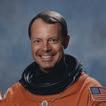












Jan Davis, Bio 75










Scott “Doc” Horowitz, MS AE 79, PhD AE 82














Michael “Rich” Clifford, MS AE 82


Bill McArthur, MS AE 83




Susan Kilrain, MS AE 85
Sandra Magnus, PhD CerE 96

Doug Wheelock, MS AE 92



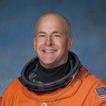
Alan “Dex” Poindexter, AE 86







Compiled by Joanna Xiao, Aerospace Engineering student ORGANIZED BY














Davis




























Eric Boe, MS EE 97





Shane Kimbrough, MS OR 98





Tim Kopra, MS AE 95
























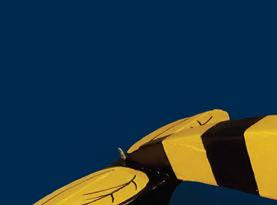








BBEFORE LED LIGHT SHOWS or the flag corps, Georgia Tech football halftime performances in the late 1940s to early 1950s featured a mini air show with control-line airplanes. The planes predated remote control toy vehicles.


BY JACK PURDY, BA








“It’s a hobby that was really big in the ’40s and ’50s, and to some extent, the ’60s,” says Mat Waites, MS ICS 81, whose father, Bill Waites, AE 55, piloted the planes at Tech a er


spending his childhood ying them.
e planes are powered with a glow plug engine that requires heat from an external battery to start the engine. Once powered, the planes are steered with two wires (hence the name, control line) by its pilot on the ground.
As a pandemic-era hobby, Waites restored his father’s control-line airplane, replacing the wood and fabric that made up the body of the plane, which helps the sturdiness of the plane.
“The body of the plane is solid sheets of balsa wood. The wings are covered with heavy paper that’s like the cloth used to make a tea bag,” Waites says.



During performances at Georgia Tech, two planes were often flown at halftime in formation performing simple stunts. One plane was the Yellow Jacket, and the other would be painted to represent the opposing team. Two planes were used not only for the performance, but also in case one broke down and couldn’t y.
According to an account that the late Bob Barton, AE 56, one of the control-line pilots, wrote for the Living History Program, “it became superstition that if the Yellow Jacket didn’t y, Tech would lose the football game. When something like this happened, you can imagine the elation of the opponent’s fans.”
The grand finale of the performance was the Yellow Jacket taking down the opposing plane.
In 2023, Mat Waites donated his father’s plane to the Georgia Tech Archives, where it currently resides.

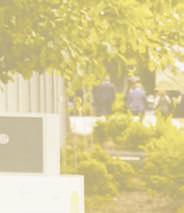
Build a better Georgia Tech for future generations and continue the Institute’s legacy of excellence by being a part of Roll Call’s Leadership Circle. The generosity and dedicated giving of Leadership Circle donors builds future leaders by laying the groundwork for current student success.




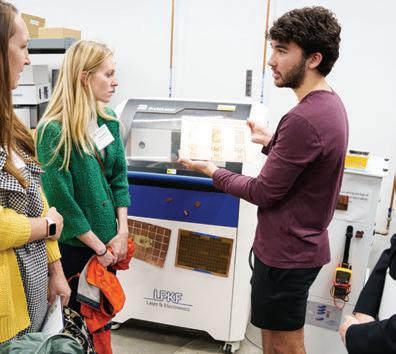














Special opportunities for recent graduates! To learn more, visit GTalumni.org/LeadershipGiving



